#certainly suggests how much they adapted the character to the kind of actor he is
Text
the thing about jason statham being originally the actor knight wanted for tommy is that it WOULD have prevented the world wide phenomenon of men getting that silly haircut because statham is like. bald.
#he does not have hair you can cut like that#they gave that haircut to cillian murphy specifically and he hates it so much lol#certainly suggests how much they adapted the character to the kind of actor he is#monkey's paw type of situation me thinks
8 notes
·
View notes
Text
Welcome! Please read before interacting!
This is just a silly little rp blog, I've fallen back into WKM and WMW obsession and crave the characters SO MUCH so why not make yet another social media account centered around them
Admin intro!
Wilford's is further down
But hey, call me Night! Ooc i am 22, I don't rp nsfw with anybody under 18. My time zone is EST and am most active from 4 pm to 2 am. My rp style is literate, sometimes more or less depending on who I'm roleplaying with. My favorite tropes are angst, fluff, enemies to lovers, and action. In addition to rp I will be posting fics, headcanons, and art here as well.
Wilford intro!
Certainly crazy, but not as much as you might think.
After literally taking the lives of others and seeing them get back up, with the help of how weird reality seemed to be afterwards, Wilford forgot. He forgot EVERYTHING. A subconscious decision his mind made for him for him to cope. Now he's a crazy, happy, party animal. He loves martinis and disco. He insists he doesn't have some weird magical abilities, and claims he's just "learned to adapt to the world around him." He can appear anywhere he wants to in reality, and can read people's thoughts if he wants to. He can bend some images of reality to his liking, nothing major but just little details. Like if he needs a small object.
If interacting pre WMW:
He still doesn't remember anything. Abe hasn't found him, and he's spent his days happy. If someone were to make him remember, it would be a really hard blow to his mental state. He'd try very hard to hold on to the peace he had found, trying to block out everything as he did before. But it wouldn't work, as he now is hanging around (your character) who reminded him of everything. It would be very hard to break down his walls and get him to talk about anything he was feeling, but it would be clear that he is struggling from his demeanor. But, if he doesn't remember what happened, he would be a crazy, happy party animal still.
If interacting post WMW:
He's not as happy as he once was. With his memories of his trauma and the causation of others traumas, he's changed. Not completely. He's still kinda crazy, definitely eccentric, but he's a bit more understanding of his fellow human beings now. He's more caring, and wants to be there for others- those he likes, anyway. He spent so long feeling nothing but happiness that now he feels every emotion very intensely. He loves deeply, rages occasionally, and gets depressed at times.
My ships and muses!
Muses:
Wilford Warfstache (obviously)
Damien
The colonel
Actor Mark
Darkiplier
The Host
Abe
Irl Mark occasionally
Ships:
ABESTACHE!!!! I prefer abestache over anything else!
Darkstache
Wilford x Actor Mark
Wilford x Yancy
Wilford x Engineer Mark
Other ships:
Damien x Actor Mark
Damien x Abe
Actor Mark x Abe
Darkiplier x Actor Mark
And you can suggest a ship not listed and I will let you know what I think! Very rarely I'm open to OC pairings, and I only do mxm ships.
Headcanons!
Wilford lives in a small one bedroom apartment, everything decorated with pink and rainbows.
Wilford is pansexual and is open about his sexuality
He is genderfluid, specifically between male-aligned and some non binary genders. His pronouns are he/him.
He likes dabbling in femininity, though cautious about who knows that if not a modern setting.
He loves the idea of settling down with someone, despite how much it seems to be the opposite
He either owns or will buy an axolotl, because "it is a strange but beautiful creature, like me!"
Loves alchohol and sometimes worse things
Rules
Not much, just be respectful. I will let you know if I won't be able to answer for longer than a day, and if I haven't explained that and haven't answered in 48 hours you can remind me. Just send a reminder, don't resend your rp reply. That's kind of rude in my opinion. I am open to nsfw, only if you're 18+. We'll discuss triggers together, I have a few headcanons that may be triggering to others so I won't post those publicly. I find anything less than a couple sentences to be boring and am never really motivated to answer those. Respect my rules, I will respect yours!
Rp tags!
Louise- #themadmansregrets
Abe- #dancingwithmadmen
Dark- #themadmansforgiver
Other Wilfords- #matchingwiththemadness
Celine- #madlovelongforgotten
And yeah that's it! I may add a few things here and there. My dms and asks are always open, so feel free to start a convo or dm to rp!
For asks, just clarify if you're speaking to pre or post WMW Wilford, as that will determine how he answers.
Thanks for stopping by!

#abestache#markiplier wilford#wilford warfstache#wilfordmotherlovingwarfstache#markiplier#markipler egos#who killed markiplier#detective abe#roleplay#markiplier rp#wilford Warfstache rp#damien markiplier#mayor damien#actor mark#the colonel#colonel markiplier#wkm#wkm damien#wkm actor mark#wkm abe#wmw#wmw abe#wmw Wilford#Warfstache#markiplier warfstache#darkiplier#the host#youtube#youtube lore#markiplier lore
12 notes
·
View notes
Text
[movie review] the thing (1982)
“you don’t wanna hurt anybody!”[1]
i love scifi/horror, especially from around this period. actually, fuck, i might just be thinking of this and alien. that being said, please please please feel free to recommend me movies with similar vibes and quality if there are such things!![2]
the isolated, desolate setting is a big part of the appeal here. it’s funny that i like snowy settings so much in movies, but i just love how much it can contribute to the mood of a setting? it can make cozy movies cozier, creepy movies creepier. you can do so many interesting things with it visually, which this movie takes ample advantage of. but i actually hate snow in real life?[3]
kurt russell is also a big part of the appeal. i’ve said this before, but i think any movie that has an all-male cast should be required to have kurt russell. it’s like basically the least you can do. i don’t have a crush on him or anything–he’s super not my type. he just makes every movie he’s in better. he exudes a kind of effortless, rugged masculinity, the kind you also get from a harrison ford or a michael douglas, those types of guys. it’s kind of perfect for a scifi/horror if you can’t get sigourney weaver.
okay, yeah, we’re back to the alien comparisons. this certainly has a lot in common with it. whereas a lot of scifi tries to astonish, both try to keep their non-monster stuff grounded and relatable to enhance the horror of their monster stuff. their settings are inherently dangerous–antarctica and space–and both are made even more dangerous by the monsters.
i also noticed a lot more this time what pains the actors (and director, and editor) went through to make the characters feel a lot more human and grounded. everybody does things a bit more awkwardly and realistically than you often get in movies. there’s a scene where macready is going to check on the helicopter that blair has smashed, and he kind of stumbles on his way to it and struggles with the tarp a few times before actually getting a peek beneath it. the camera doesn’t track either of these things the way you would expect it to if it were intentional. there’s a few times i noticed him making choices like these, and he’s not the only one. it just adds a little texture of realism and verisimilitude to his performance.
the monster effects are pretty outlandish, and they totally hold up on the big screen. i’d even go so far as to say they’re more effective on the big screen. i sometimes struggle to enjoy the gross out brand of horror, but carpenter deploys it here in ways that work for me quite a bit more than a raimi or cronenberg does.
i know faithfulness to who goes there? is hardly a metric most people are concerned about with the thing, given that it has without a doubt surpassed the novella it’s based on as the ur-text of this story. still, unlike the thing from another world before it, this is definitely a “based on” not a “suggested by.”
a few things are moved around–macready’s name is spelled differently and he’s the helicopter pilot instead of second in command, the expedition’s complement is a more manageable 12 instead of 37. plenty of details are also expanded upon or altered completely. a lot of the discoveries being related to the team in the infodumps by macready and blair in the text are instead moved to a separate, norwegian (or is it swedish, mac?) expedition. this allows us to see through the characters’ eyes as they investigate the other doomed expedition’s base at a slow and methodical pace, making everything feel even more grounded and creepy.
but compared to the thing from another world which has differently-named characters fighting some sort of super carrot man (and even changes its setting from the south pole to the north pole, seemingly out of spite), this is actually a pretty faithful adaptation. again, not that it matters.
what really astonishes me is that when approached about the project, carpenter was reluctant because he didn’t think he could improve upon the thing from another world. the man is either seeing something i’m not in that movie, or is in possession of an overabundance of humility that’s directly proportional to his skill as a director.
or maybe he was just trying to be merciful, because he absolutely blew the earlier adaptation out of the water in every category.
s-rank
notes
1. yeah, i know most people would probably go with the extremely obvious/iconic “nobody trusts anybody now and we’re all very tired” if they were gonna open with a quote. and it’s for sure one of my favorite lines in the movie, too. but there’s a couple times macready is deescalating and says “you don’t want to hurt anybody,” and it’s just weirdly meaningful to me. i believe the kids would say i vibe with it.
2. just to preempt literally everyone suggesting it: yes, i’ve seen the fly. i wasn’t a fan at the time, but i should probably give it another shot at some point.
3. or, at least, i used to? i’ve been living in california for a few years now, so it’s easy to forget how awful chicago and new england winters were.
1 note
·
View note
Text
The Witcher: The Games vs the Books part 2 – Characters and Accents
So, I've already talked at length about the relationship between the Witcher books and games, but how well they captured individual characters is its whole own subject – and you’d better believe I have enough thoughts on it for a whole extra post.

Andrej Sapkowski's skill for creating vivid and engaging characters really is so much of what brings the books to life, and no matter how much work an adaptation might put into worldbuilding and plot, it's the characters you've really got to nail to get the long-time fans on board. Especially when you’ve done what the games have, framing themselves as a direct continuation of Sapkowski's story. Nothing invites comparison to your source material like basically forcing fans to read the original novels to understand even half the backstory alluded to in-game.
So how did they do? I can only offer my opinion – characterisation is necessarily going to be a lot more subjective than just telling you what plot points the games contradicted outright – but like any fan, I have opinions in plenty.
Of the main cast, I feel Yennefer is the character they've captured the best. They've done just as well with some supporting players – I have no real complaints about Dijkstra or Phillipa, for example, who are favourites of mine in both games and books. For the main players though, Geralt and Regis seem to be the ones who's differences I'm most inclined to forgive, whereas I don't feel like they've done Ciri justice at all. Book!Geralt is much less of a smartarse, for one thing, whereas Book!Ciri is much more of one. But if we're talking about the differences, I’m afraid we really need to start with Dandelion.
Dandelion
For all the genuinely good work the games do with characters, old and new, I don't think I can overstate what a disservice the they've done Dandelion, who I could not stand in TW3, but is now one of my favourite book!verse characters. Alas, Dandelion is a prime example of something the Witcher games really don't do well: camp. Being the archtypical bard, Dandelion is about as flamboyant as any enthusiastically-heterosexual man can be: you should be able to spot this guy by body language alone, he should be flouncing around and he should talk like a spoiled noble auditioning for Shakespeare. Book!Dandelion is over-the-top and ridiculous and just so much fun, and I loved him well before I'd even really gotten into the rest of the books around him.
Here's just a bit of dialogue from one of his first appearances, to give you a sense of how he and Geralt play off each other.
The bard seized the fingerboard of his lute and plucked the strings vigorously. ‘How would you prefer it, in verse or in normal speech?’
‘Normal speech.’
‘As you please,’ Dandelion said, not putting his lute down. ‘Listen then, noble gentlemen, to what occurred a week ago near the free town of Barefield. ‘Twas thus, that at the crack of dawn, when the rising sun had barely tinged pink the shrouds of mist hanging pendent above the meadows—’
‘It was supposed to be normal speech,’ Geralt reminded him.
‘Isn’t it? Very well, very well. I understand. Concise, without metaphors. A dragon alighted on the pastures outside Barefield.’
Though TW3's Dandelion certainly looks the part, you have to go hunting through art from the Gwent cards to find much that comes close to really capturing his personality (see left pic below – though even there, a Dandelion who'd voluntarily break his treasured lute is a very hard sell). Though a lot of fanart does better (right-below – credit goes to Tatiana Ortaliz).
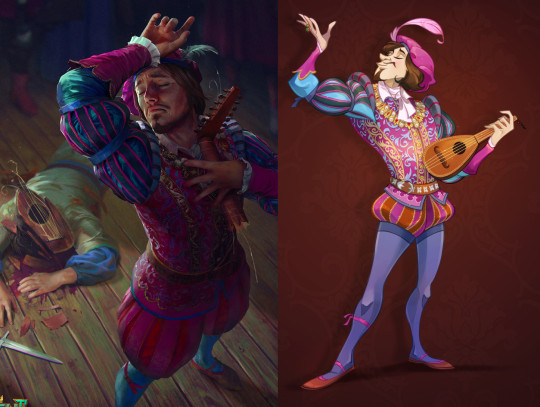
But as poorly as the games capture his flamboyance, they're not that much better when it comes to taking him seriously. TW3 left me thinking he was all talk and no substance; the books make abundantly clear that he really is renowned enough to be welcome in courts across the continent. Though he often overestimates what he can talk himself out of, he isn’t stupid either: he's lectured at Oxenfurt, spied for Dijkstra, and then there are the moments where the frivolous playboy mask slips and you realise he's sometimes much better at understanding people and relationships than Geralt will ever be (which is honestly kind of funny considering how many of Dandelion’s relationships end with plates being thrown at him from an upper story). He's not at all above mocking Geralt when he deserves it either (and especially his personal and relationship issues) – Geralt will happily mock him right back.
We never do learn how they became friends (I'm pretty sure the incident listed in the wiki is just the date of their first expedition together, not their first meeting), but Geralt just doesn't form lasting friendships or romances with anyone he can't have an intelligent conversation with. And Dandelion is a damn good friend to Geralt – one who, despite being a helpless, squishy little bard, will keep Geralt's secrets under torture, or will follow him into Nilfgaard in the middle of a war simply because you don't let a friend make a trip like that alone. (Seriously, I don’t ship it nearly as much as some, but hot damn there is some material in here if you do.) In short, it's basically inconceivable that he'd leave an amnesic Geralt wandering around Vizima alone, as he does in the first Witcher game – which is the kind of thing I can mostly forgive as a gameplay conceit, only it doesn’t really get better from there.
He’s also supposed to be blond, something I don’t think is technically specified until fairly late in the novels, but 100% what I’d been picturing since his first description as a man in a colourful bonnet with cornflower-blue eyes (let’s face it: Dandelion’s hair isn’t the only thing about him that screams ‘blond’). It’s a shame no-one from the games to the show to the novels’ cover artists seem to have noticed – but at least there are some fanartists out there who were paying attention (credit for these goes to Asphaloth, Ghostcupdraws, Hvit-ravn (tumblr deleted), 94355 and itsmespicaa).

As for the games? Well, I cannot speak to how Dandelion came across in the original Polish, but I think it speaks worlds about the priorities of the English version that they didn’t even bother to cast someone with a halfway-decent singing voice as their master bard. There are isolated moments of dialogue that come close to sounding like book!Dandelion– mostly in Witcher 2, which comes closer to capturing the spirit of the books than either 1 or 3, or his attempts to convince his captor he's a disguised noble when you rescue him TW3 – but his voice actor is just painfully ill-suited to the role.
Geralt
Geralt fares much better than Dandelion, though he’s still a little hard to square with the Geralt of the books. Book!Geralt spends a lot more time sulking, just to begin with: he sulks because his job is complicated and gets him no respect, and because the world is unjust and unfair – and, most of all, he sulks because Yennefer has dumped him again. He also gets mocked for sulking, and usually deserves it. Book!Geralt is generally a lot more taciturn and a less prone to making smart comments just to have something to say – arguably because in book!Geralt's world, making smart comments often ends at the gallows, or at least with some corrupt official making your life much harder. Book!Geralt's world kind of sucks, and he's just got to put up with it.
As much as he often plays into the expectations of being an uneducated monster hunter, he's also got a more of an intellectual streak than you’d guess. He may prefer to stay out of politics (because damnit, his job is to save people from monsters, not people who are monsters), but he attended school at Nenneke's temple and has even taken classes at Oxenfurt academy, and there's a lot of thoughtful nuance to his opinions – his speech to Ciri about why he can't in good conscience take a stronger stance against the Scoiata'el contains a wealth of historical perspective, just for one example. Even his smart comments tend to be, well, somewhat smarter in the books.
Book!Geralt’s explicitly a lot younger than Yennefer – around 50 is the usual estimate, falling far short of the 100-ish the games suggest (the scandal of having a man fall for – gasp! – an older woman clearly didn’t bother Sapkowski one bit). You don’t see nearly as much "I'm getting too old for this" from book!Geralt, who's really not that old by witcher standards, and is apparently still hunting monsters long into his future. I'm also a little annoyed by the way they play off his hatred of portals like he's a grumpy old man who doesn't like mobile phones, when his distrust originally came from having seen the gruesome deaths that result when portals go wrong. This is not to say Book!Geralt lacks other ordinary human flaws, however – twice in the last two books of the main saga, he gets severely sidetracked after his ego gets the better of him (in the adulation he receives after being knighted, then after arriving in Toussaint), and it's quite some time before he properly gets back on track for that whole rescuing-Ciri thing again. He’s also pretty hopeless when it comes to romance and relationships – breaking things off gracefully is really not in his skillset.
So why does game!Geralt not bother me more? Well, he's the main player character of a game franchise, and one who has to carry the experience largely solo. Some adjustments for genre are pretty much inevitable in that position. He's certainly fared better than Meve, for example, who's been softened far more from her book characterisation for her PC role in Thronebreaker. Then there's the whole amnesia thing – it's easy to believe that sort of experience would change a man – and if he doesn't sulk so much as he used to, maybe he's grown up a bit. Geralt's also in many ways the straight-man of Sapkowski's Witcher universe – there largely as the reliable centre for other, louder personalities to play off. But I expect the real bottom line here is that I do still like game!Geralt enough to forgive him a lot of what he lacks.
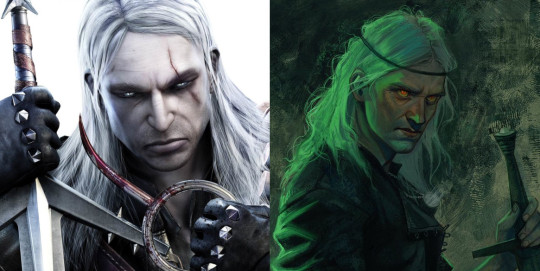
The books never do describe Geralt as being very attractive – something book-based fanart often tries to reflect. The point has been made before that the rather-alien-looking Geralt of the first game (left pic above) is probably a lot closer to his book-description. However, the main distinguishing factor you’ll see in book-based fanart is probably the ubiquitous headband, which genuinely is what book!Geralt wears to make his hair behave (the example on the right above comes from Diana Novich).
All that said, if Sapkowski really wants me to believe that nearly so many women are eager to jump into bed with him, I’m going to have to shallowly assume our witnesses are unreliable on this front, and Geralt is at least as attractive as Witcher 3′s take on him. Nothing else makes sense. *g*
Regis
Regis varies mostly in that book!Regis is a lot more smug, sometimes verging on obnoxious – and a lot keener to make fun of Geralt (who generally deserves it). But then, Regis is old and wise and superpowered enough to dance rings around most everyone else – can you blame him? By Blood and Wine, Regis' overconfidence has been recently smacked down hard after his near-death-experience at the hands of Vilgefortz, and that kind of thing could knock some chips off anyone's shoulder. Throw in the fact that with Dettlaff, we have a situation not even Regis could make light of, and the changes to game!Regis make a certain amount of sense.
I do feel it's a bit of a shame that the vocal direction didn't work just a little bit harder to capture some of Regis' smugger side, or emphasise that his long-winded philosophising on human behaviour is supposed to sound a bit pretentious. This is actually something I suspect they were going for a few times in the script, but which didn't come through in the dialogue quite the way it was meant to. Still, again, I'm sure I'm biased by the fact that I like game!Regis far too much to find much fault in what they've done with him. They've done a lovely job capturing his friendship with Geralt too.
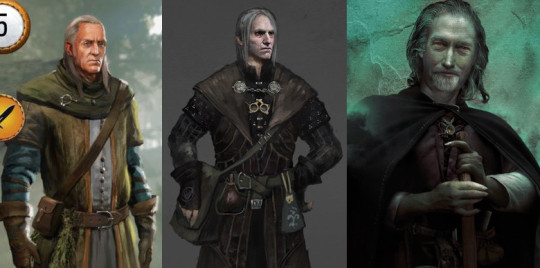
Looks-wise, there's a tendency in book-based art to portray Regis with long hair (even some pre-Blood-and-Wine Gwent art did so – see the two pics on the left above, from Gwent and early B&W concepts. The right-most pic is cover art from the books). I couldn't rightly tell you where long-haired-Regis comes from, though – perhaps it's described more explicitly in the original Polish, or perhaps it comes up in passing in some passage I've forgotten, though it may just as well just be a fannish meme.
The books do describe him as looking rather like a tax collector, slim, middle-aged, with an aquiline nose, prone to wearing black, and his hair as 'greying' or 'grey streaked', so presumably somewhat younger-looking than the game would have it. The hammer-horror-esque sideburns are likewise a game-verse addition, though I do like the look they went with – it's distinct from Geralt in a way that making him another long-grey-haired man wouldn't have been, and that's probably the point.
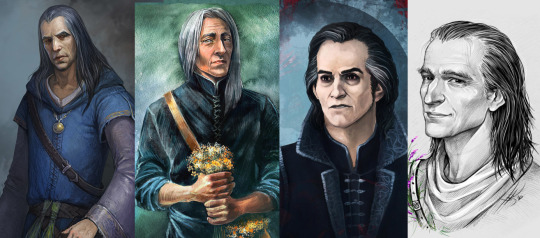
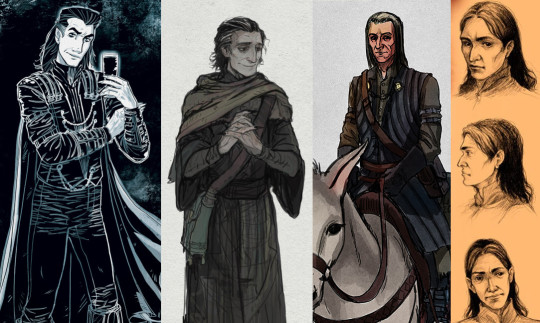
Being the hopeless Regis fan I am, I have quite the folder full of different fanart takes on book!Regis, so have a selection – art here is by gellihana-art, justanor, greysmartwolf, Nastyaskaya, NatalyLanier, beidak, natalliel, ellaine and afternoon63. For what it’s worth, I feel beidak’s (bottom pic, second from the left) comes the closest to what I’d have pictured personally, based on how he’s first described.
Ciri
I find it much harder to rationalise the changes to game!Ciri, who I didn't exactly dislike, but found stuck too close to the role of generic-macguffin-girl-who-just-wants-to-be-normal to be very interesting. Having read the books, not only do I much prefer book!Ciri, I'm not sure I can emphasize enough how much the game did NOT prepare me for utter gauntlet of whump and misery that girl survives in the last four titles. Book!Ciri is a character who works for me mostly because of the same flaws the game mostly strips her free of – TW3 makes some token noise about how you can't tell her what to do, but she’s an utter little royal brat when we first meet book!Ciri, and it’s so much of what brings her to life. She throws herself into her witcher training with the enthusiasm of a kid going completely native, but still revels in getting to be girly for a change when Triss first arrives at Kaer Morhen. She hates Yennefer at first, but soon bonds with her just as strongly as she ever did with Geralt, picking up some of Yennfer’s haughty mannerisms along the way. And then she gets thrown through a portal and lost in the distant wilderness, and the whole world comes down on her head.
The build up to the first time Ciri actually has to kill someone is intense... and things only get worse from there. Steadily. For another couple of novels at a stretch. Seriously, a major caveat that pretty much has to go into any rec for these books (and I will absolutely rec these books) is that Ciri's story gets heavy. So heavy one finds oneself using phrases like, "that time that one guy died of his wounds on top of her while semi-consensually feeling her up was honestly one of the less traumatic incidents in the period."
By the end of the novels, Ciri has nearly died of thirst, been beaten, tied up, dragged around the country as a prisoner, run with bandits and killed innocent people for the fun of it, done fantasy-cocaine and got a tattoo, fought off more than one attempted rape, been drugged, lain for multiple nights next to an impotent elf who completely fails to impregnate her, watched the bodies of her friends and girlfriend being mutilated in front of her, and did I mention where she got that scar? She has survived hell, and it is absolutely a testament to her own strength that she somehow comes through it and puts herself back together at the end. When Geralt finally arrives to rescue her, what matters most isn't that her ordeal is over, but that she finally knows she hasn’t been abandoned by everyone who’d ever loved her after all.
The Ciri of the books is fierce and wild and arrogant, but she's learned her morals from the best, and she holds onto them until she can't, then picks them back up again when she can, and above all she survives. For all that her story turns arguably too much of the last two books into a slog of misery, oh boy does it pay off at the end. And that's probably about as much as I can say about her Big Moment in the last book without spoiling too much, so suffice to say that by the end of the saga, Geralt has pretty much become a supporting character in Ciri's story, not the other way around. (Seriously, you’d be surprised how few chapters of the last two books he’s actually in.)

Finding art which captures the aspects of Ciri’s character and history which are missing from the game has turned out to be pretty hard, though the fanart above from her bandit phase takes a decent crack at it (credit to Loles Romero and NastyaSkaya). I do rather like that one shot of her on horseback beside her girlfriend too, which comes from Denis Gordeev’s illustrations for the novels (below).
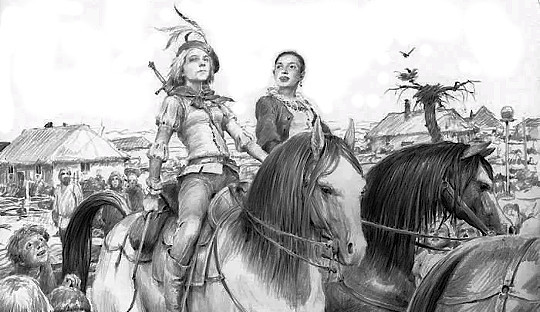
How much of this does TW3 get across with her portrayal in the game? Well, she's still pretty headstrong, I guess. And they let you give a 'sorry, I like girls' answer in one bit of dialogue, so they remembered her girlfriend existed. That's nice. But game!Ciri still has a kind of wide-eyed innocence that book!Ciri lost years ago, while book!Ciri is a little force of nature in ways the games hardly even hint at, and that's a really shameful loss.
You'd think, with a character so young, it ought to be easier to imagine she's simply grown up since we saw her last, but so much of what's changed about Ciri feels like a step back rather than forwards. I can shrug off Geralt and Regis' differences and still enjoy their game-verse-selves, but Ciri leaves me genuinely disappointed.
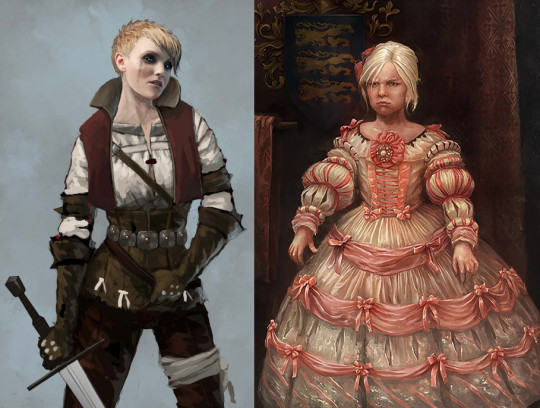
I’d say the official art that comes closest to capturing book!Ciri is that one portrait of her as a very grumpy young child (right above). Some of the early concept art (left above) feels a little more like it has her attitude, though she’s rather too yellow-blonde – not to mention too pretty. I think it also bears pointing out that Ciri isn’t really supposed to be the kind of beauty she is in the game – even before she gets what’s meant to be a seriously ugly and disfiguring scar. (Fanart below by justanor and bobolip)

But of course, the male gamer fanbase can’t be expected to give a fuck about a girl they wouldn’t want to fuck, so game!Ciri must be generically gorgeous. Le sigh.
Triss
I suppose I should at least touch on Triss, too, though she's a very odd case. She's so out of character in the first Witcher game that I am wryly amused that the biggest thing they arguably do get right is that taking advantage of Geralt the moment he showed up with amnesia is... pretty well in-character for her (look, I gotta be honest here, I'm not much of a fan of Triss in any of her incarnations).
The second game does a much better job with her – she actually feels like book!Triss, she has some good dialogue, we're finally dealing with some of her conflicted loyalties to the Lodge and to Geralt – though by the third, her characterisation has been so softened into “the nice one” that none of that potentially meaty conflict is ever resolved, or even really mentioned. Perhaps there's more buried in the Triss-romance path, which I've never bothered with, but the writers seem to have just given up on dealing with anything that might make her look less than wholly sympathetic. Heck, we hardly even get a clear statement about why she and Geralt broke up between Witchers 2 and 3.
Even speaking as such a not-a-fan of Triss, I promise there is more they could've done with the character the books give us. There's her ongoing trauma in from the Battle of Sodden, where she was injured so badly she was memorialised as one the dead: the 14th of the hill. There's her furious impatience with the neutrality of both the witchers and the Lodge: Triss has fought and died for a cause, and is ready to do so again. The second game sort of gets into this, but by and large, the games really aren't up to tackling the moral complexity of having such a theoretically-sympathetic character as Triss, who was still broadly willing to go along with the Lodge's plans to pair Ciri off and get her pregnant as soon as possible – her own wishes be damned. No, instead, Triss has conveniently left the Lodge before the rest of them go spiraling into abject villainy in the second game, clearing all that messy grey stuff out of the conflict.
Of course, the really big unresolved plot point still hanging over book!Triss is how badly she needs to terms with the fact Geralt's just Not That Into Her, and never has been – but since the games want Triss to be a serious romantic option, that's definitely not getting the resolution it could've used.
Book!Triss also pointedly avoids any outfit with a plunging neckline because her chest is covered with the ugly scars she received in the Battle of Sodden, something the games did not have the guts to reproduce. In a more confusing note, the books do consistently describe her hair as 'chestnut', which we'd usually think of as meaning 'brown' – though it turns out the games actually may not have been wrong to make her a redhead, since in Poland 'chestnut hair' apparently mean dark red hair (google some pictures of actual chestnuts, and you'll see why). Still, the firy-red-haired Triss of TW3 who wears nothing but plunging necklines remains a bit of a stretch, however you slice it. Once again, TW2 gets her best (and I must say, gave her the nicest outfit) – though even here she's conspicuously unscarred in all her sex scenes.
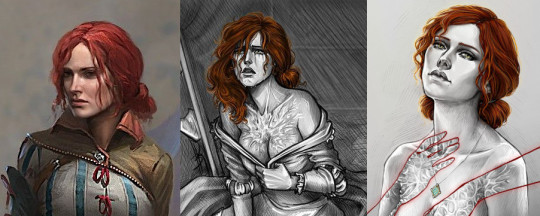
(Leftmost pic above is official Witcher 2 art, whereas Triss-with-scars fanart comes to us – once again – from nastyaskaya)
Shani
Shani sort of falls into a similar category as Triss as someone who isn't terribly well-served by any of her appearances, given that both exist in the first game largely to compete for Geralt's attentions. But I can't honestly say I find Shani’s portrayal in the Hearts of Stone expansion to be much better – the degree to which either version exists solely to fall all over Geralt is a bit painful, especially given that their relationship in the books is limited to a single, undramatic hook-up. Book!Shani really only appears in a couple of chapters: we meet her as a medical student friend of Dandelion's, who's been surreptitiously selling pilfered university supplies to fund her degree, then later see her again in the final book, where she proves herself as a battlefield medic during the climactic Battle of Brenna. She's pragmatic to a fault, and I really can't see her as the type who needs Geralt to point out to her that her patient is dead, for example, or who'd subject a guy with Geralt's problems to such an extended feelings-dump as you'll get out of her during the wedding.
Shani is a reasonably logical book-character to bring back, if only because she’s one of those who explicitly survives the ending, but for my money, "serious contender for Geralt's affections" is just not a role she works in.
Anna Henrietta
The duchess of Toussaint, Anna Henrietta, is another case who differs more from her book counterpart than you might think. In the books, the duchess is by far the least competent of the (pleasantly many and) various female leaders and rulers we meet – she comes across as rather young and naive, and every bit as absurd as everyone else in the ridiculous fairy-tale duchy she rules. She is, for example, most displeased to learn that Nilfgaard's war against the north is ongoing (something her courtiers have carefully avoided mentioning in her presence), because she'd long since sent the Emperor a stern note demanding he brought it to an end. She promptly has one of her ministers sent to the tower for misinforming her, and demands the others prepare an even sterner note for the emperor, which will surely do the job.
After Dandelion (inevitably) cheats on her, she has him repeatedly sent to the gallows, only to change her mind and send him a reprieve at the very last minute each time. Picture yourself a much younger and prettier version of the Queen of Hearts from Alice in Wonderland, and you've about got her general vibe.
Blood and Wine sort of waves at this part of her character when she first speaks about Dandelion, and again in suggesting there's a widespread feeling she lacks compassion, and once more as she proves utterly immovable on the subject of her sister. But the generally sensible and insightful woman you deal with for most of the main story is a far cry from her book-verse characterisation. That’s a bit of a shame, because I feel like there's a lot more they could have done to blend the two versions of her. Still, it’s hard to argue the duchess we get suits the story being told around her.
Other characters
Much as I love Yennefer, Dijkstra and Phillipa, I don't really have much more to say about them because I feel the games have done such a good job. The Yennefer of the books gets to show a lot more depth and complexity simply because she has more scenes and more space in which to do so, but when ‘there isn’t more of her’ is your biggest complaint, the game is officially doing pretty well. I could certainly gripe her about how “dresses in black and white” seems to have been taken as “dresses in black with maybe a trace of white trim”, or how Yennefer and Triss seem to be the only sorceresses in the world capable of wearing pants, when Phillipa (just for one) is in sensible men’s clothing the very first time we meet her, but that’s getting into serious nitpicking territory.

(Not that Yen can’t look amazing in outfits with more white – art by Emily Caroll, theclashofqueens, BarbaraRosiak, and cosplay by greatqueenlina)
Vesimir, Lambert and Eskel, Geralt's fellow witchers from the School of the Wolf, fall into a similar category for me – though we spend far less time with them in the books, everything we see of them in the games feels like a fairly logical extension of their book-roles. Vesimir is somewhat over-played as the old fogey, and his death is painfully cliched, but the impact on the characters and Kaer Morhen still hits home – and the games do some especially great work expanding Lambert into a much more complex character. To my mind, the only shame is that more of the book-original characters didn't get the same treatment.
Who have I missed? There's Avallac'h, of course, but I think I've got him pretty well covered by that last post. Zoltan, perhaps inevitably, has had his personality largely flattened into 'generic dwarf', with nothing better to do than hang around Geralt and Dandelion. You wouldn't know Book!Zoltan was apparently incapable of turning away women and children in need, for example – even human women and children with the chronic inability to say thankyou for his help. Or that he eventually admits to Geralt that the luggage he and his friends are carrying comes from a decidedly unsavoury source for such a supposedly charitable, upstanding guy. Yes, even Zoltan gets to be a morally complicated character in the books – who knew?
Speaking of dwarves, pleased as I am that Yarpen Zigren gets remembered in TW2, he's an odd one to talk about, since even in the books, he appears to have had a substantial personality transplant between his two main appearances. Yarpen’s a largely comedic figure in The Bounds of Reason short story, where he cheerfully admits to having considered letting his men knock down a particularly pompous aristocrat and piss all over him to teach him a lesson, but he’s evolved into a studious voice of reason against the scoiata'el by Blood of Elves. TW2 doesn't do a particularly good job of capturing either version, which I suspect probably bothered me more than most people – I liked the later book-incarnation of Yarpen immensely (and not even just because he's one of few ever to really call Triss out on just how much she needs to stop misreading Geralt's friendship as anything more than it is). His chapter in Blood of Elves packs a hell of a punch.
On the subject of accents
I do have to wonder if I'd have warmed up to characters like Triss, Shani and Dandelion (or even Letho) more if they'd only had halfway decent voice actors. It's not just that none are exactly leading the talent at the acting part of the job, it's that their American accents stick out in TW3 like a sore thumb.
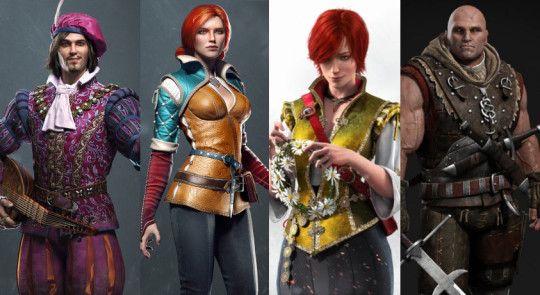
Geralt mostly gets away his own US accent by dint of being the very first character we meet, so we've gotten used to the way he talks long before we notice how he stands out – hell, maybe that's just how they talk down in Rivia (hilariously, book!Geralt eventually reveals he's not even from Rivia, but simply picked the place and taught himself the accent so he could feel a bit less like the abandoned foundling he is, which only gives us yet more excuse for why his accent might sound a bit weird). More importantly, Geralt is meant to stand out, to be the outsider wherever he goes, so having him sound like no-one else fits the character.
But neither Triss or Dandelion are "of Rivia", and by the time they show up we've had dozens of hours in a game where literally everyone else sounds British, or Scottish, or Irish, or vaguely-eastern-European in the case of the Nilfgaardians. So why do these weirdos sound like no-one else on the continent?
The short answer seems to be that every character with an American accent in TW3 is someone who had an American accent in at least one of the previous games, which were way looser with their casting and had enough incidental American accents around that they didn't stand out. Clearly, by TW3, consistency with prior games has been prioritised over consistency with literally anything else we’re hearing.
Gaetan is an exception to the rule as the only new character (at least that I caught) with an American accent – presumably because between Geralt, Eskel, Lambert, Berengar, and Letho (and cohorts), some sort of 'witchers have American accents' rule has been pretty well established (another random American-accented witcher shows up in Thronebreaker, just to underline the point). We're going to mostly ignore Jad Karadin here, since his British accent is presumably a recent affectation to go with his new identity, and so makes sense.
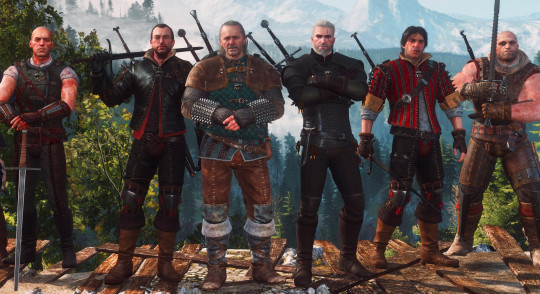
This still doesn't really work though, since Letho’s school is all the way down in Nilfgaard (land of the Eastern European accents), while the oldest witcher from Kaer Morhen (Vesimir) is the one guy with a British accent. He sounds nothing like any of his students, despite the fact he's logically the guy they ought to have learned their accents from. So the logic falls in a heap however you slice it, and I'm thrown right out of the game.
With TW3 as your intro to the series, it feels almost as if characters like Triss and Dandelion have been assigned American accents because they're just too important to be saddled with the same pedestrian British accents as everyone else, which did nothing to endear them to me. The only one I eventually warmed up to was Lambert, and then only because he's just such a bitter asshole that he eventually goes full circle and comes out the other side (somewhere around when you've heard his miserable backstory, then gotten drunk together and told him how much you love him, man). Gaetan similarly snuck in under the same clause – American accents clearly work better for me in this series when attached to characters you're supposed to find pretty insufferable on first impressions.
Some final notes
To conclude, it seems only fair to throw in a quick nod to some of the more memorable book-characters who don't appear in the games. Neither Mother Nenneke (Geralt's sort-of-surrogate mother) or Vissena (Geralt's biological mother) ever appear either, alas – Vissena doesn't even merit so much as a Gwent card, which seems quite the wasted opportunity.
Milva, Cahir and Angouleme – the three remaining companions of Geralt’s who died alongside Regis but who were not so easily resurrected – naturally don’t appear. But nor are even really mentioned in all the games, which seems rather less than they deserve after giving their lives to Geralt's cause.
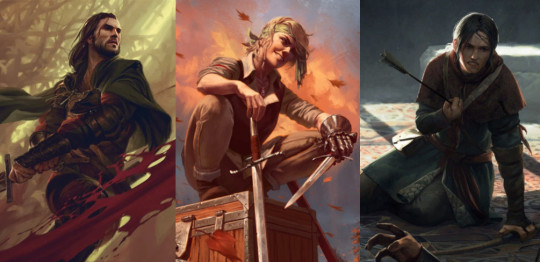
Cahir and Angouleme do at least have pretty badass Gwent cards to their names, though I am properly offended that Milva (who has the dubious honour of being my very favourite book character who doesn't ever appear in the games) is stuck with a card of her freaking death scene – which not only gets the scene wrong (believe me, there was no grimacing and gripping the arrow buried shallowly in her chest for poor Milva), but doesn't even bother to get her hair the right colour, for fuck’s sake. Basically, Milva was a stone cold badass and absolutely deserves better. #justice4milva
One can only guess how I'd have felt about some of these characters had I read the books before playing the games – I am obviously biased towards forgiving changes to characters whom I liked in their game incarnations, regardless of how they compare. Still, I think it does speak wonders that there still all these characters who suddenly made sense only after I'd met them in the books.
Even if only for Dandelion and Ciri, I can only dream of seeing a bit more of the book-original characterisations make it into the collective fannish consciousness. There's nothing wrong with getting into the canon purely based on the show or the games, but having read Sapkowski's novels, it's no longer any mystery how they spawned this massive franchise. That the saga wasn’t even fully available in English until well after Witcher 3 was released – a solid couple of decades late, and long after it had already been translated into Russian, French, German, Spanish and more – is a real shame. For once, it’s us in the anglophone world who’ve been missing out: these books deserve so much more than to be thought of as a footnote to the games or the show.
#Dandelion#Witcher novels#Jaskier#Ciri#Regis#Geralt of Rivia#meta#The Witcher#long post is even longer this time#I blame everyone who gave me such lovely feedback on that last post *g*
76 notes
·
View notes
Text
New Colin Morgan Interview with Edge Media Network about Benjamin - UPDATED
I am reblogging this because, after the author was made aware of an error in the posting of his article (if anyone clicked through to read it on the site, there was a whole question and answer that was repeated), the error was corrected and another three questions and answers were added! I am correcting it here, but they were very interesting, so I suggest you read the full article again!
I shall post the link at the bottom, but I wanted to type it out so that non-English speakers could more easily translate it. (This article was listed in their “Gay News” section of the site, hence the focus on the gay roles.)
British Actor Colin Morgan: How the Queerly Idiosyncratic ‘Benjamin’ Spoke to Him
by Frank J. Avelia
In writer-director Simon Amstell’s sweet, idiosyncratic, semi-autobiographical comedy, “Benjamin,” Colin Morgan plays the titular character, an insecure filmmaker trying to resuscitate his waning career (at least it’s waning in his mind) after one major cine-indie success. Benjamin is also doing his best to navigate a new relationship with a young French musician (Phenix Brossard of “Departures”).
Thanks to the truly endearing, multifaceted talents of Morgan, Benjamin feels like an authentic creation--one that most audiences can empathize with. Sure, he’s peculiar, has a legion of self-esteem issues and an almost exasperating need for acceptance as well as an inconvenient talent to self-sabotage the good in his life. But who can’t relate to some or all of that?
“Benjamin” is one of the better queer-themed films to come out in recent years, in large part because it eschews emphasis on the queer nature of the story. Instead, the film is a fascinating character study with Morgan slowly revealing layers and unpacking Benjamin’s emotional baggage.
Morgan is a major talent who has been appearing across mediums in Britain for many years. His London theatre debut was in DBC Pierre’s satire, “Vernon God Little” (2007), followed by the stage adaptation of Pedro Almodovar’s “All About My Mother” (2007), opposite Diana Rigg. Numerous and eclectic stage work followed (right up until the Corona shutdown) including Pedro Miguel Rozo’s “Our Private Life” (2011), where he played a bipolar gay, Jez Butterworth’s dark comedy, “Mojo” (2013), Arthur Miller’s “All My Sons” opposite Sally Field (2019), and Caryl Churchill’s “A Number” (2020), to name a few.
His TV work includes, “Merlin” (playing the wizard himself), “Humans” and most recently, in a very memorable episode of “The Crown”. Onscreen he can be seen in “Testament of Youth”, “Legend” with Tom Hardy, “Snow White and the Huntsman” and Rupert Everett’s take on Oscar Wilde, “The Happy Prince.”
He’s played a host of gay roles in the past on stage, screen and TV.
EDGE recently interviewed the star of “Benjamin” about the new film and his career.
Why Benjamin?
EDGE: What drew you to this project and were you part of its development?
Colin Morgan: It’s always the strength of the script for me on any project and Simon’s script was just so well observed, he managed to combine humor and poignancy in delicate measure and when I first read it I found myself being both tickled and touched. Then reading it again and from “the actor” POV... I knew it would be a real challenge and uncharted territory for me to explore. I auditioned for Simon and we tried it in different ways and then when I was lucky enough for Simon to want me on board, we began to work through the script together, because it was clear that this was going to be a very close working relationship... it was important for the level of trust to be high.
EDGE: I appreciated that this was a queer love story where the character’s queerness wasn’t the main focus. Was that also part of the allure of the project?
CM: I think Benjamin’s sexuality is just quite naturally who he is and therefore that’s a given, we’re on his journey to find meaning and love and there’s certainly a freshness to what Simon has written in not making sexuality the main focus.
Great chemistry
EDGE: Can you speak a but about the process involved in working with Amstell on the character and his journey?
CM: Simon and me worked very closely over a period of weeks, at that time prior to shooting I was doing a theatre project not far from where he lived so I would go to him and rehearse and discuss through the whole script all afternoon before going to do the show that night, so that worked out well. It’s so personal to Simon, and to have had him as my guide and source throughout was fantastic because I could ask him all the questions and he could be the best barometer for the truth of the character; a rare opportunity for an actor and one that was so essential for building Benjamin. But ultimately Simon wanted Benjamin to emerge from somewhere inside me and he gave me so much freedom to do that also.
EDGE: You had great chemistry with Phenix Brossard. Did you get to rehearse?
CM: Phenix is fantastic, Simon and me did chemistry reads with a few different actors who were all very good but Phenix just had an extra something we felt Benjamin would be drawn to. We did a little bit of rehearsal together but because it was a relationship that was trying to find itself there was a lot of room for spontaneity and uncertainty between us, which is what the allure of a new relationship is all about, the excitement and fear.
Liberating process
EDGE: Did your process meld with Amstell’s?
CM: I’ve said this a lot before and it’s true, Simon is one of the best directors I’ve worked with. Everything he created before shooting and then maintained on set was special. We always did improvised versions of most scenes and always the scripted version too. It was such a creative and liberating process. That is exactly the way I love to work. And for a director to maintain that level of bravery, trust and experimental play throughout the whole shoot stands as one of the most rewarding shooting experiences I’ve had.
EDGE: When I spoke with Rupert Everett about “The Happy Prince,” he very proudly boasted about his ensemble. Can you speak about working with Rupert as he balanced wearing a number of creative hats?
CM: Again, this was an extremely rewarding project to work on and quite a similar relationship as with Simon in the respect that Rupert was the writer/director and Oscar Wilde is so personal to him. And then we also had many scenes together in front of the camera, so Rupert and me had a real 3D experience together. It was a long time in the making. I was on board, I think, two years before we actually got shooting so I had a lot of time to work with Rupert and rehearse. He really inspired me, watching him wear all the different creative hats, such a challenging and difficult job/jobs to achieve and he really excelled--plus we just got on very well.
Playing queer roles
EDGE: You haven’t shied away from playing queer roles. Do you think we’re moving closer to a time when a person’s sexual orientation is of little consequence to the stories being told, or should it always matter? Or perhaps we need to continue to evolve as a culture for it to matter less or not at all...
CM: That’s a hard question to answer, I think certainly the shift in people’s attitudes has changed considerably for the better compared to 40 years ago, but there will always be resistance to change and acceptance from individuals and groups whether it be sexuality, religion, race, gender--we’re seeing it every day.
Evolution is, of course, inevitable, but if we can learn from the past as we evolve that would be the ideal. Unfortunately, we rarely do learn, and history repeats itself.
EDGE: You were featured prominently in one of my favorite episodes of the “The Crown” (”Bubbikins”) as the fictional journo John Armstrong. Can you speak a bit about working on the show and with the great Jane Lapotaire?
CM: I had an exceptionally good time working on “The Crown.” Director Benjamin Caron, especially, was so prepared and creative, and made the whole experience so welcoming and inclusive. It was an incredibly happy set, with extremely talented people in every department, and I admired the ethos of the whole production and have no doubt that’s a huge ingredient to its success, along with Peter Morgan’s incredible writing.
I was also a fan of the show, and it was an honor to be part of the third season. And I can’t say enough amazing things about Jane Lapotaire. We talked a lot in between filming, and I relished every moment of that.
EDGE: You’ve done a ton of stage work. Do you have a favorite role you’ve played onstage?
CM: I’ve been so lucky with the theatre work I’ve done, to work with such special directors and work in wonderful theatres in London. I’ve worked at the Old Vic and The Young Vic twice each, and they’re always special to me. Ian Rickson is a liberating director, who I love. It’s hard to pick a favorite, because the roles have all been so different and presented different challenges, but, most recently, doing “A Number,” playing three different characters alongside Roger Allam and directed by Polly Findlay, was a really treasured experience, and I never tired of doing that show, every performance was challenging as it was.
Miss the rehearsal room
EDGE: You were doing “A Number” earlier this year. Did you finish your run before the lockdown/shutdown?
CM: Just about! We had our final performance, and then lockdown happened days later. I feel very sorry for the productions that didn’t get the sense of completion of finishing a run. I mean, finishing a full run leaves you in a kind of post-show void anyway, even though you know it’s coming, so to not know it’s coming and have it severed must be even more of a void.
Memories of performing just months ago seem like such an unattainable thing in this COVID world right now. I can’t tell you how much I’m hoping we get back to some semblance of live performance.
EDGE: What was it like to appear onstage opposite Dame Diana Rigg in “All About My Mother?”
CM: Well, I think “iconic” is an apt word for both the experience of working with Diana and the lady herself. In between scenes backstage we used to talk a lot and we got told off for talking too loudly, so Diana began to teach me sign language and we would spell out words to each other, maybe only getting a couple of sentences to each other before she was due on stage and I had to get into position for my next entrance-- we did a radio play together two years ago and she remembered, she said, “Do you remember A-E-I-O-U?” signing out the letters with her hands.
EDGE: None of us knows the future in terms of the pandemic and when we might return to making theatre. I’m a playwright myself and find it all supremely frustrating but I’m trying to remain hopeful! Where are you right now in terms of the standstill we are in and what the future might hold?
CM: Yes, I’m so worried for theatre. It’s a devastating blow. I’m sure as a playwright, you know that the creative spirit in individuals hasn’t been diminished by this virus. People are creating important art in this crisis but we need the platforms to present it and bring people to some light again out of this really scary period, but it needs to be safe and it’s a worrying time. The virtual theatre approach must be looked at I think. We need to experiment and find new paths at least for the time being. I’m involved in developing some things right now and how we can work on things in both an isolated and collaborative way. It’s entirely counterintuitive to what the family-feel and close bond of a group in a rehearsal room is like-- I miss the rehearsal room so much!-- but we can’t sit still, we must create and we must act.
What’s in a role?
EDGE: Looking back on the great success of “Merlin,” what are your takeaways from that experience?
CM: Some of the most treasured memories of my life will forever be connected to “Merlin,” the cast, crew, production, everyone! The invaluable training of being in front of a camera every day! The chance to inhabit a character and live with him for five seasons! There’s too much to list and words probably won’t do justice anyway, but I’m truly grateful for everything the show gave me.
EDGE: How do you select the roles you play?
CM: I guess they select me in a way. I can’t play a role unless it speaks to me and provokes me in some way, but ultimately it’s the characters that I have a fear about playing, not knowing how I’m going to enter into the process of living them, when I don’t have all the answers it’s a good indicator of a character I must play. If I have all the answers, there’s less scope for exploration and discovery which isn’t as interesting for me.
Link here
146 notes
·
View notes
Text
Movie Review | The American Friend (Wenders, 1977)

More than most of our great actors, Dennis Hopper's personal life and career are difficult to separate from his performances. Here's a man who started off in studio pictures, directed one of the defining films of the American new wave, had his next film buried and was cast off into the wild, so to speak, as his drug problems escalated, and after a successful stint in rehab, found a second career playing great movie psychos. This is an extremely simplified summary of his life and career, and Hopper certainly had films in each era that buck the trends I refer to, from his early role in Curtis Harrington's strange and mystifying Night Tide, to his directorial success with gritty cop drama Colors to his turn as a villainous real estate tycoon in Land of the Dead (a film whose satirical points proved to be entirely on target when I revisited it last year), but the point still stands. I mean, you look at his role as a photojournalist under Kurtz's spell in Apocalypse Now, his best known role during his "wilderness" years, and it doesn't seem too far off from the real Hopper. Wim Wenders' The American Friend was another film Hopper made during these years, and by Wenders' account, his initial behaviour very much justified that reputation. (Apparently a night of partying helped patch up any disagreements on set.)
Here Hopper plays Tom Ripley, that great psychopath of print and screen, but what will struck any viewer familiar with the source material is how unusual a fit he is for the role. Certainly there's no one way to play Ripley. One need only look at the different film adaptations, where he's been played by actors as diverse in style as Hopper, Alain Delon, John Malkovich and (in the shamefully yet to be seen by me Anthony Minghella film, given its reputation in menswear circles) Matt Damon. And Ripley himself changes between novels. Compare the insecure, aspiring character in The Talented Mr. Ripley to the survival instinct in Ripley Under Ground to the strange benevolence of Ripley's Game, of which this is an adaptation. When reading the source novel, I pictured Ripley as cold, composed and calculating, an approach Malkovich took in Liliana Cavani's adaptation a few decades later. (I like that movie quite a bit, but if one must quibble, Malkovich plays the role perhaps too conventionally.) Hopper is anything but. He's impulsive, mercurial and tortured, and comes sideways to the material yet in a way that's ultimately quite fitting. We can believe this is a man who would seek to ruin Bruno Ganz's hero's life over a minor insult and also a man who would stick his neck out to assist the man he wronged over something so meager, if only to rebalance the scales of cosmic justice. Movie psychos don't always adhere to the psychological realities of real life sociopaths, but Hopper's anguished demeanour makes the portrayal work.
Hopper also diverges from other incarnations of the character in his wardrobe. The Talented Mr. Ripley, set in an Italian resort town, suggests that its characters should be sporting relaxed, maybe a little louche, vacation wear, which is certainly the case in its adaptations. Ripley's Game has an older, more discreet Ripley, and Cavani's adaptation has him dressed fairly conservatively. In contrast, Wenders has Hopper (my guess is at Hopper's insistence) decked out in workwear, sometimes in a jumpsuit, sometimes in denim (providing more evidence that a Canadian tuxedo is a good look in the right hands) and almost always with a cowboy hat. It's a look that suggests honest Americana in most contexts, but here takes on a sinister quality. ("What's wrong with a cowboy in Hamburg?" he asks, none too reassuringly.) Highsmith as an American ex-pat living in Europe likely had a different relationship to the character than Wenders, a German in West Germany, and one can read a political and cultural dimension into the way Ripley, an American, influences sometimes nefariously and sometimes beneficently the life of the German hero. The hero's initial disgust at Ripley's involvement in an art forgery scheme, a plot point lifted from Ripley Under Ground, seems pretty pointed in this respect. Lest I suggest that Wenders' views towards Americans and their cinema are entirely ambivalent, it's worth noting that he casts crucial supporting roles with Nicholas Ray and Samuel Fuller. (He also places Jean Eustache in a brief scene, but one which hits a key narrative beat.) To an extent, their casting plays as iconography, and a moment where Hopper parts from Ray, the former marching towards a modern skyscraper while the latter is framed against an aging building, feels like an attempt by Wenders to find a place for his movie, loosely falling in that very American genre of film noir, in the context of both American and German tradition.
In adapting Highsmith's work, Wenders shuffled the settings to place most of the action in Hamburg, and perhaps because of the contrast with his preceding road movies, he seems particularly interested in the realities of the location. There is of course the scene I mentioned above, and the way the joyless industrial settings seem to colour the mood. (That mood is of course enhanced by the cinematography by the great Robby Müller, which is a masterclass in its use of colour. The fluorescent lighting is bold yet harsh and chilly, creating a movie that's gorgeous to look at yet a little oppressive to spend time in.) Ripley's lair even looks like a crude cartoon sketch of the White House, which again plays into the movie's curious yet critical view of American iconography (a quality which would bloom in Paris, Texas). This kind of specificity also ties nicely into its qualities as a thriller, of which this is a terrific example. The movie's most thrilling sequence (shot both on a moving train and also in the studio, with the footage later assembled with immaculate timing) is the hit on the train, where the hero, eventually assisted by Ripley, has to devise and perform a pair of murders in a crowded, cramped, moving train and dispose of the bodies without anybody noticing, sometimes hiding bodies in the bathroom, sometimes stashing weapons in different nooks, sometimes fleeing to unattended cars (the hero sticks his head out a window at the train's rear and cries in relief, as seen in the bizarre visual of a helicopter shot that makes it look like the bright red train is moving backwards). I also think of the way the victim's body tumbles down the escalator after Ganz's character performs his first hit and the sight of Ganz fleeing the subway as seen through the security camera, which evokes the feeling of being trapped by the location and enhances the subsequent sense of freedom and exhilaration experienced by the hero. Ganz's character is a good man, but Highsmith understands and Wenders captures the subversive thrill his terminally ill character might get from checking out, however briefly, from societally accepted morality. If the movie has a weak spot, it's the character of his wife, whose concern for her husband and suspicion of his activities make her a firm moral centre but also a little one note. But one suspects this is less a result of a failing of Wenders and Lisa Kreuzer, who plays the character quite sympathetically, and more from Highsmith's comparative disinterest in the good and normal. Bad guys are just so much more interesting.
3 notes
·
View notes
Text
Astaire & Rogers Rewatch Part 2: Gay Divorcee
• Once again, background info first.
After they were a smash hit in Flying Down to Rio, Astaire and Rogers were quickly paired up for another film. Gay Divorcee is an adaptation of a successful stage musical (Gay Divorce), which Astaire had starred in immediately prior to coming to Hollywood. It was the only major production he did on the stage without his sister. More on this later.
Why the name change? Execs didn’t think a gay (happy) divorce was appropriate but a happy divorcee was acceptable.
Back in the day, the only way I could watch classic films was checking them out for a dollar from my local library. When I checked out Gay Divorcee, the librarian commented that title certainly had a different connotation today than back then. This meant nothing to me as a young person at the time but now I think about that moment every time I think about this film.
• Our characters/actors: Guy (Fred Astaire), Mimi (Ginger Rogers), Aunt Hortense (Alice Brady), Egbert (Edward Everett Horton), Tonetti (Erik Rhodes).
• What kind of name is Egbert??
• “I’m on my vacation. I’m not gonna do any dancing.” Unless there’s a beautiful woman to woo, of course. Or a check to pay.
• The bugle call is heard for the first time in the Astaire/Rogers films when he begins his solo. It will pop up several more times in the next films but it originated as something funny from Astaire and Rogers’ rehearsals. In Roberta and Follow the Fleet, art imitates life in a way when the bugle call becomes a signal of their past partnership/connection.
• Guy’s gentle mocking of Mimi’s repeated calls for a porter will come back later in this film and be slyly referenced again in Swing Time.
• Heh:
Guy, hopefully: “You didn’t say goodbye.”
Mimi, coldly: “No, I didn’t.”
• The subtitles very incorrectly indicate Egbert says “asked” each time he repeats what the English messenger said when delivering Guy’s coat. Egbert, in his attempt to mimic the English accent, distinctly says, “arsed.”
• Love this exchange:
Egbert: “What’s her name?”
Guy: “I don’t know.”
Egbert: “Where does she live?”
Guy, more emphatically: “I don’t know.”
Egbert: “My, what an interesting romance.”
• Astaire often thought his singing voice sounded better right after he’d had a drink or a smoke. So he usually does one or the other (often the latter) in scenes right before singing.
• Already his speaking-singing style is to his advantage as he sings “Needle in a Haystack” while finishing getting dressed. It seems natural and effortless, the way we all sing to ourselves sometimes.
• Love how he leaps over the back of the couch and the way his tapping kicks up with the four horn blasts in the song. No one makes a more stylish exit than Fred Astaire lbr.

• Mimi, having been blocked in by Guy’s car: “Would you mind moving your car, or don’t you want it anymore?”
• And here he repeats her call for a porter to break the ice and it works. She may think he’s a little nuts but she’s clearly interested. When he asks when he can see her again, Rogers lets a look of longing and regret flash over her face. Neither the audience or Guy know yet that she’s actually still married and trying to discretely get a divorce. Going out with another man would ruin everything but this charming dork is tempting.
• Buuuut she’s not so interested that she cares at all about destroying his elaborately packed picnic basket when given the chance to speed away. And he’s so into her already, he also couldn’t care less.
• One of my favorite lines here from Guy:
Egbert: “Guy, you’re not pining for that girl are you?”
Guy: “Pining? Men don’t pine. Girls pine. Men just… suffer.”
• Ok, the “Let's K-nock K-nees” sequence is something I skip every time because it’s pointless and insane that young Betty Grable is somehow into Egbert. And that opinion has not changed.
• Hortense and Egbert are part of the comic relief but I have always found them annoying. Thy do have some good lines though:
Egbert: “You can’t have a clandestine affair between three people.”
Hortense: “Oh, that’s what you say.”
• “Your wife is safe with Tonetti. He prefers spaghetti.”

• I like that Guy legit almost leaps over the second story railing to follow Mimi before thinking better of it. He's got it bad.
• “Night and Day” is the only song from the stage musical to make it into the movie and it’s also the first dance duet Astaire and Rogers have performed since the “Carioca.” And it is worlds different and stunningly executed. Future films won’t make audiences wait nearly an hour before pairing up Astaire and Rogers for a dance.
• Although Mimi asks Guy to let her leave, she smiles instantly when he again asks her to stay. The whole time he sings to her and for most of the dance, she’s very obviously conflicted and Rogers portrays that beautifully. Some of it is the choreography but most of it is her acting. Just one of many, many examples of, as one film historian put it, Ginger Rogers realizing that “the acting did not stop when dancing began.”
• If you think I’m going to shut up about Astaire’s singing, you’re dead wrong. “Night and Day” is a love song with lines like “this torment won’t be through, ‘til you let me spend my life making love to you.” When Frank Sinatra sings that line, it’s seductive. When Fred Astaire does, it’s a sentiment straight from his heart.
• Astaire’s look when he grabs Rogers’ hand and the music kicks up as he does a little dance. Love it.
• This dance is incredibly intimate. When he twirls her in close for the first time, they lean together, noses almost touching. Her dress is pressed to his suit in several places.
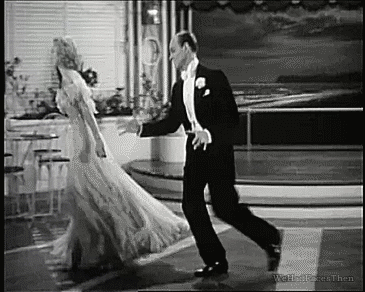
• Each time they move apart, they come back together slowly, her arm gently on his shoulder, his around her waist. When they’re side by side, again noses almost touching they’re so close, a smile spreads slowly on her face and he responds in kind.
• It’s after that moment that, for the first time in the dance, he lets her go and they dance together without either holding the other, a signal of their characters’ growing intimacy and partnership. Any other “attempts” by Mimi to leave are all playacting within the dance. She is right where she wants to be.
• Two movies before a song will induce it, Astaire and Rogers dance cheek to cheek for a few brief seconds in “Night and Day.” As the music turns triumphant, he smiles and she looks a bit rapturous. He doesn’t take his gaze off her for a second and she meets his look without breaking it even after the dance is over.
• Love the tiny wiggle of Astaire’s fingers as the music dies down, his leg still lifted in the final pose of their dance.

(gif credit)
• The implications of his offer of a cigarette as her chest is heaving a bit and after such an intimate moment are, um, obvious. 😏😏😏
• A lot of this movie is about sex or the suggestion of sex. “The Continental” involves kissing while dancing. Mimi must pretend to be caught in an affair in order to get a divorce. “Night and Day” mentions “making love.” When Mimi instructs Guy to meet her in her room at midnight, he’s shocked but he shows up and more than once goes to embrace her since he assumes that’s why he’s there. But, as usual in Astaire/Rogers films, the sexiest moments are tied up in the dancing and “Night and Day” is one of the clearest examples.
• Mimi may have thought Guy was her corespondent because he “said the right words” but there’s something to be said for how suave and charming he was in their dance. Mimi had no trouble believing he might be a hot guy who was hired to help women convince their husbands they were having an affair.
• As Rogers starts to sing “The Continental,” Astaire looks at her so warmly right before the shot switches to a close-up where he’s supposed to stare affectionately at her. But his genuine look before the switch is better.
• Rogers’ dress change before “The Continental” is a good one. That negligee and hairstyle were not the most flattering and her new dress is one of my favorites.
• “The Continental” is very different than the “Carioca” even though it’s meant to replicate it in many ways. But Astaire’s control over the choreography is much more evident. He and Rogers switch from the prescribed motions of the dance to more energetic pieces seamlessly. Several times he sneaks smiles at her that appear to be Astaire himself, rather than solely his character, such as when they turn towards each other with their arms outstretched for the first time or when she begins marching forward first and he follows.
• The “three steps to the right, three to the left” move that will be integral to the choreography in Swing Time, shows up here first.
• Pretty sure he nearly gets punched in the face when they link hands and spin so each has one arm in front and one behind.
• Kissing her hand, rather than her lips, in response to the lyric “you kiss while you’re dancing,” is just the start of a longer conversation about (the lack of) kisses in Astaire/Rogers films. More later.
• The affection on both their faces in the close up near the end of the dance as they twirl around one another (in a slight mockery of the kissing other couples were doing) is very sweet. And I love the final move when he spins her towards him on that last beat and instantly smiles broadly. It’s a look I’d expect to see during rehearsals when you’ve finally done a tricky move perfectly.

• For some reason, RKO thought what people wanted was several more minutes of this song without Astaire or Rogers, and they were wrong. At 17.5 minutes, “The Continental” was the longest musical number on film until the ballet sequence in An American in Paris outran it... by one minute.
• When Astaire and Rogers do rejoin the dance briefly, you can see how well they flow together. Critics and historians have often noted that Rogers wasn’t the most technically perfect or trained of Astaire’s partners but she looks pretty damn perfect. They switch from formal dancing to tap to spins to twirling down steps and she doesn’t ever look out of her league for a second.
• And this is somehow only their second film and third on screen dance together! And yet they already look incredible??
• In the morning, Mimi and Guy’s relationship is so obviously cemented and we know it not by grandiose declarations but in the small action of her grinning and calling him “clown” after he jokes about the arrival of their breakfast.
• So Mimi’s husband shows up and doesn’t buy Tonetti is her lover for a second because duh. She calls Guy out from hiding to kiss her as proof she’s having an affair of some kind. And he obliges… by kissing her cheek somewhat ridiculously. 🤦♀️
• Their final dance as they get ready to leave takes them around the room. I love how he leaps over the couch, not unlike he did back when he was pining for her in “Needle in a Haystack,” and then slides across the rug to reach her in time for the next step.
• “The Table Dance” that ends the film is another carryover from the stage production. As Astaire guides Rogers from the table down to the floor, her foot doesn’t stop on the chair as his does. It goes from table to floor in one motion. For one beat both of her feet are touching nothing. The move relies entirely on his control and her trust in him. Not an easy ask, not only because of the maneuver but also because Astaire’s stage partner did hurt herself during this dance at one point and the injury eventually led to the end of her career. Maybe that’s why Astaire quickly glances down at the chair on each rotation.
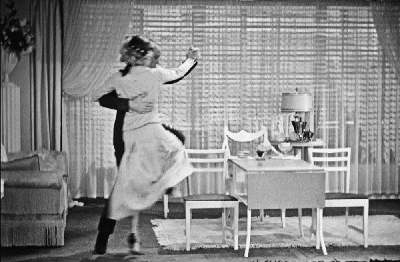
• And in the final seconds, the music becomes jaunty and the pair look at each other and grin with complete sincerity. For just half a second before he grabs a hat, Astaire looks at her with that same softness you see in other moments. The way she leans into him as they exit is in character, yes, but it’s like two friends thoroughly enjoying themselves, which they were in both respects.
• So movie two finished! If you think these posts are already getting long, just you wait. Roberta is next and it’s one of my favorites.
#fred astaire#ginger rogers#the gay divorcee#classic hollywood#old hollywood#fred and ginger#astaire and rogers rewatch
24 notes
·
View notes
Text
Sonic: The Hedgehog (2020)
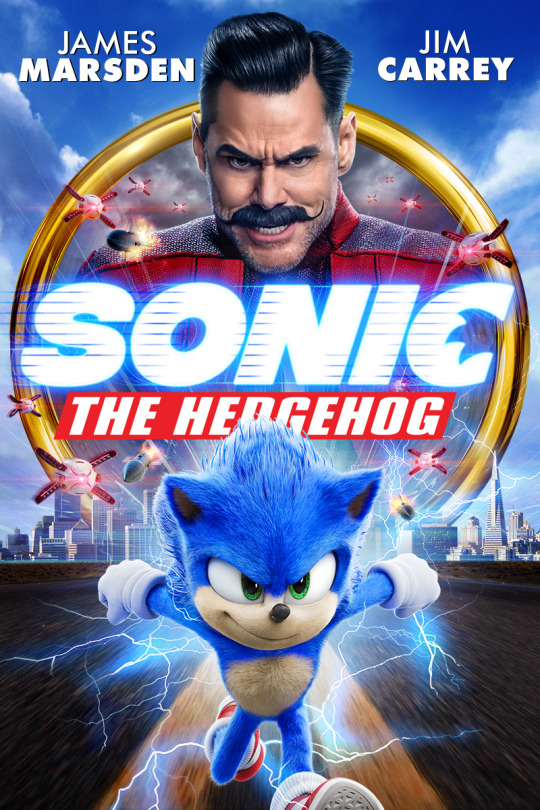
Sonic: The Hedgehog (2020)
Greeting my flock of film freaks and welcome again to the Cult of Cult. Todays offering is a bit more of the mainstream blockbuster variety, but as films based on Video Games are still actually quite niche and vastly underestimated I think we should open our hearts to Sonic: The Hedgehog and hope that we find it a pleasing tithe to the cult. I am your beloved minster, The Reverend Chainsaw, and welcome to today’s service.
The Message
I must confess to the congregation that I was drinking mighty heavily of the lord’s Tennessee sour mash when I was taking in this movie. That said, I think that this is a great movie to have a drink with and I mean that in the best possible way.
Sonic: The Hedgehog is of course based on the Sega video game franchise and stars Ben Schwartz as the titular blue rat. Schwartz brings his brand of high energy enthusiastic comedy to the voice role. While Schwartz is particularly on brand for Schwartz, is he on brand for Sonic? I’m not entirely sure, but I’m also not entirely sure I was ever in love with the old ways. I am not an avid fan or consumer of Sonic media and perhaps that means I am in a poor position to say. I am most familiar with the Sega games and Sonic cartoons from the 90s, and from what I have grasped the more recent entries with their more anime centric and high lore plots still owe quite a bit to the attitude era of the 90s. Sonic was a hero but he was also a bit of a cross between Mickey Mouse, the Flash, and Bart Simpson. As an angsty 90s boy I wanted to eat chili dogs and go very fast that was very appealing to me, but I’m not so sure it would be appealing to a vast audience of older millennials, or even todays kids. And though I think it would be a fair criticism to say that Ben Schwartz is playing sonic as basically the superhero version of his Dewey Duck from the VERY VERY good DuckTales reboot, I don’t think that it’s necessarily a bad thing.
Dewey Duck the Hedgehog is a small mammal (also not a rodent, I wanted to say rodent and apparently hedgehogs are not rodents, just googled it) from an alien planet where his adoptive mother, an owl named Long Claw, fears that he will be hunted for his special powers, which I think is just super speed but it might be other things. In line with these concerns after an attack by pursuers Longclaw gives Sonic the Moses treatment and floats the special blue boy down the metaphorical river. Unlike Moses, however, Sonic is not found by ultra rich ultra powerful extra special people but is instead alone. Sonic lives alone in exile outside a small American town as a sort of local cryptid.
Thus begins a charming adventure. Through a poor decision to use his powers while working out some personal issues, Sonic inadvertantly draws the attention of the U.S Government and their nasty big brain baddy Dr. Robotnik. Sonic recruits a small town police officer with big city dreams to assist him in finding his magic rings so that he might flee from earth to an uninhabited mushroom kingdom.
Now about these two human characters. Officer Everyman is played by cyclops from the X-men franchise. The actors name escapes me and so does the characters, and while, yes, I just looked up if hedgehogs were rodents, I will not be looking up this information. I like the review better this way. It makes me laugh. And while I don’t remember his name, I do remember that he used to live In Mt. Juliet, TN. Anyway, what you should know about Officer Goodguy is that he drives a Toyota Tacoma!
That Toyota Tacoma is also continuously abused by the mad machinations of our films biggest draw: Jim Carey as Dr. Robotnik. If we were to pitch a Sonic movie, I don’t think anyone would jump to Jim Carey as the must have for the role, but after seeing this film, boy was it the best choice. The way he chews the scenery and plays off the rest of the cast and situations is just so much fun to watch. It’s fantastic to see Jim Carey back in a larger than life role. The Decision to play Jim Carey as the kind of condescending nerd who has taken their lack of social skills and leaned in as opposed to working on themselves was a brilliant choice. We’ve all known that kind of guy who tries to play the misanthrope just because they are too egotistical to recognize their flaws. Here Dr. Robotnik has given up on human connection in favor of subordination. His intellect is his only value, and thus he demands everyone around him acknowledge intellect as the only quality that matters as he has. It was a great choice.
From the point the chase begins the film becomes a road trip flick, and despite the fact that Sonic could supposedly cover the distance required in the blink of an eye we watch the ins and outs of our heroes relationship as they learn what home, and being a hero mean to them. By the climax it is pretty by the numbers, Sonic has come to feel at home on Earth and now that he has friends who care for him they can begin to make a world from which neither will have to flee; and of course, they beat the bad guy. FOR NOW. we are treated to an even crazier Dr. Robotnik stranded in the Fungus Dimension bent on revenge.
The Benediction
Now for all things Holy and Profane in this film, please rise for the Benediction.
Best Scandal: Sonic the Cosmic Horror
The original look of this film was mired in dread when the early footage and trailers dropped revealing a hideously uncanny hedgehog monster in the form of sonic. The memes are amazing, the toys are unsettling, there’s still plenty of Quasimodo Sonic stuff out there floating on the web and I suggest that you search it out, the laughter is good for your heart. Also if anyone wants to send me any creepy sonic merch I’ll take it.
Thanks to the work of online fans and internet harassments, the studio felt it was going to lose money on the project and reeled back the release allowing for the design department to give us a more cartoony but less frightening alien monster. I mean he’s a cartoon, it’s okay for him to look like a cartoon.
Best Scene: Noodle Dance
It’s hard to choose, and it feels a bit biased, but there are a few scenes with Dr. Robotnik that are just what make the movie more than a forgettable IP adaptation. Not that Ben Schwartz wasn’t doing great as the character but I feel Sonic as a whole would be lost in the milieu of CG spectacles and Super Hero Origin stories that we are bombarded with every year if not for Jim Carey’s performances; and even with them Sonic: The Hedgehog is not completely out of those woods. That said, I think Dr. Robotnik’s Alone Time Dance Party has to be the stand out sequence in my memory. I can’t really speak to what makes it so enjoyable, but damn if it isn’t just the best scene in the movie.
Best Character: Silicon Valley Dr. Robotnik
Do I even need to say it? It’s Dr. Robotnik. I’m not a fan of this villain from any other media. I always found Dr. Robotniks look unappealing, I’m not a huge fan of his powers, or using robot henchman. it always struck me as pretty boring how Sonic didn’t have a cool rogues gallery (i’m talking about 90s sonic) the way Mario did. However, they did something with the design, characterization, and performance that just made him such a fun villain. Also, my friend Jacksons mom said I looked like him and it didn’t hurt my feelings so.
Best Actor: Jim Carey
Jim Carey. It really seems like he’s all I’m talking about in this movie. Once again, I think Ben Schwartz did great and Sonic IS basically Dewey Duck in this movie. Dewey Duck is my favorite part of the rebooted DuckTales series, BUT he is just outmaneuvered by Jim Carey in this role. I think it’s a compliment enough to say that Ben Schwartz was even able to keep up with his energy, let alone play his quicker perkier foil.
Worst Scene: Toyota Tacoma Commercial
Sonic: the Hedgehog’s worst scene would probably have to be the forced friend fight between Sonic and Officer Wachowski during the car chase. It’s an overproduced weightless car chase scene with a contrived buddy cop controversy meant to force apart our heroes so that they can ultimately grow a little and come back together later in the movie. Not that I mind a movie like this to be so by the numbers, but it just felt like two of the blandest things on this movies plate being forced into one scene. I do like the idea of giving me the crap part of the dish in one flavorless generic bite, but that still doesn’t save it from being the worst scene in the movie.
That Toyota Tacoma took a beating though.
Worst Feature: Nothing Ventured/ Nothing Earned
I’m sure many fans would feel that the worst feature of the film is that it isn’t loyal to any previous lore laden version of the character, (probably the one they like the most). In the portrayals of both Sonic and Dr. Robotnik there were decisions made that drastically differed from the ways they have been portrayed before. Sonic is naïve and idealistic, a bit childish, Dr. Robotnik is driven by a lot of insecurity. Where are the Chaos Crystals and my original character Grindy the Wolf Cub?
But I think that these are over all positive choices in a film that otherwise chose to play it incredibly safe. In their cautious approach to appeal to the widest possible audience the film makers gave us a pleasant and appealing cartoon romp but we are left with little to hold on to. The worst feature of Sonic: The Hedgehog is it’s safety.
Summary:
Sonic: The Hedgehog is often touted as “the first good video game movie”. A label that I disagree with wholeheartedly. It is certainly a good video game movie, but it’s not the first, and it is not by leaps and bounds better than other video game movies as a whole. It’s a sub genre that gets a ton of disrespect, and in a world where the biggest criticism levied against the Super Mario Bros is that it’s not a faithful adaptation, I don’t understand how Sonic the Buddy Cop/ Road Trip comedy is escaping that attitude.
All that said, I had a good time with this movie. But it felt like playing on the playground as a toddler. You have fun and then you leave and you don’t really remember what you played or who with. I’ll think about Jim Carey and Dewey Duck, but I had a hard time hating or loving anything this movie did in any strong way. I usually feel that a movie that is “bad” or “corny” or “shlocky” is always better than a movie that is generic, or pointless, or boring. Sonics pleasantness and cheerful energy just barely save it from being another Transformers franchise. I get that origin stories are hard, so I’m eagerly awaiting the next installment, and hopefully it’s going to do something that sets it apart. Probably not.
Overall Grade: C
James Marsden! I just remembered!
#Sonic: The Hedgehog#2020#2020s#video game#sonic#hedgehog#alien#action#super hero#adventure#buddy#road trip#jim carey#james marsden#ben schwartz#scifi#science fiction#dr#dr robotnik#robotnik#C#Grade C#scientis#mad scientist#(C)
2 notes
·
View notes
Note
I never saw this show exceeding past 5 seasons max. Jodie is taking advantage of her youth and whiteness/white privilege whether she likes to realize it or not. It’s not a shade or diss to her either honestly it is what it is. She knows she’s the 20 something pretty white actress from killing Eve & she wants to go into the film industry. Sandra is gorgeous & talented too but she’s older & Hollywood isn’t as kind & generous to older women especially POC women. I wanna see her in more films tho

But you’re not going to see Sandra Oh in more films. You know that, right?
It’s not because she’s not good enough. Sandra is a transcendent talent, but she has been cursed with the great misfortune by her parents. They effed her up from the beginning.
They didn’t make her White. Or a hot blond with more curves than the Pacific Coast Highway. She checks none of the boxes of what a leading lady in Hollywood
When you’re none of those things, you don’t get to play the lead in Oscar-bait films. Nobody is paring Oh up with Ryan Reynolds, Ben Affleck or Matt Damon or any other leading (White) man. Nobody who is spending hundreds of millions on tentpole summer movies is going to give women who look like Oh opportunities to play those kind of gigs.
Those gigs are reserved for other women. Women who look like Jodie Comer. This is not debatable. Sandra gets to play the “ethnic, but sassy” best friend of the White lead. That’s her lane as far as Hollywood is concerned. Asian women do not get to see their names above the title in Hollywood, which could be why it took a British woman adapting a novella by a British writer of a British MI5 agent who obviously was White to cast as its star someone who was neither White or British.
On Grey’s Anatomy, Oh became a star, but never was the star. Ellen Pompeo was and is, as one might expect of the titular character of a show (with a notable exception I will address in a separate post). Pompeo is considered one of the more progressive actresses in Hollywood with a Black husband, biracial kids and a $20 million annual salary, but even she is not inoculated from being occasionally clueless.
Speaking on a podcast, Pompeo said about Oh who left Grey’s in 2014, "Sandra is a different kind of actor. … You never doubt whether Sandra Oh is gonna work again, right? She’ll work forever, right? But for me, I had to think, 'Am I gonna work again? Or am I going to be so typecast?' ”
What. The. Entire. FUCK.
If you ever needed evidence that TV BFF’s don’t know shit about each other away from the camera, this is Exhibit A. Hooray for Ellen P. for getting paid and all that, but she simply sounds stupid when she says Oh is going to “work forever” when in fact she barely worked at all for four years after she hung up her scrubs.

For four years after she left Grey’s Anatomy, Sandra Oh waited. She waited for offers to come in, juicy scripts that could come alive in the hands of her Golden Globe–winning talent. Sure, she did acting work here and there; a lead turn in the indie Catfight, a cheeky supporting role in the comedy Tammy, an arc in the drama series American Crime, a few plays. But there was nothing on the scale of Cristina Yang, the sarcastic surgeon she played on Grey’s for nearly a decade—a standout performance that turned the Korean-Canadian actress into a household name, and earned her five Emmy nominations in a row. The lack of certain offers was, Oh says, heartbreaking at the time.
These days, though, the deeply pragmatic actress says she’s letting go of expectations: “That’s where I’m at. I can talk about the things that didn’t come my way that I think should come my way, but it’s just like—it’s a fuckin’ waste of time.” Besides, her four-year waiting spell eventually led to Killing Eve, a BBC America thriller premiering Sunday about a bored MI5 operative named Eve Polastri—played by Oh—who becomes obsessed with hunting down a psychotic assassin named Villanelle.
I have not worked with, nor have I ever met Ms. Oh, and I certainly do not earn anything close to $20 million a year, but if my broke Black ass knows that Sandra was indeed concerned she might not work again in the industry, what’s Pompeo’s bullshit excuse (That was a rhetorical question. There is no excuse)?
I am confused by what you mean by Jodie taking advantage of her youth and Whiteness/White Privilege. What is she supposed to do? Pass on film roles and say, “I don’t believe I should take these jobs until there is equity in opportunity for women who don’t look like me.”
Comer will never say that. Nor should she be expected to. It’s not her responsibility, nor is it within her power to be such a change agent. She’s a working actress with a window of opportunity, and while better off financially than 99.9 percent of her fans, has not made so much money as to be financially set for life.
Between Jodie C. and Sandra O. who’s more likely to join Ellen P. in the $20 million a year club?
Benefiting from being born White isn’t an original sin conceived by Comer. It predates her. Today, she may be aware the pie isn’t sliced evenly between herself and Oh, but it wasn’t for Rebel Wilson either because of how she is viewed by the world.

Consider how Wilson’s 2020 ‘Year of Health” weight loss affects her personal wellness (likely an improvement), but may impact her career opportunities and probably drastically change them when she’s no longer “Fat Amy” and instead “Fun-Sized Amy.”
Sandra knows this game. She was not being prescient when she mused, “A lot of things that I can't get into the room for, even just to be seen, is because they're just saying 'No. they're not casting non-white.' You're lumped into a category with people who are just not white.” She was merely being accurate.
Jodie does not get lumped into those categories. Looking the way she does means more that how she acts, which is not shading her skills as much as it is recognizing her baked-in advantages. She’s paid her dues and had her setbacks and disappointments, but it would be silly to ever suggest she’s had as tough a time with a Scouse accent as someone else has with a Korean heritage.
Nothing could be further from the truth to suggest anyone is dumping on J.C. for being young, blonde and pretty or trivializing her life struggles, but her blues ain’t the same as Sandra’s and never will be.
Those future movie roles you are hoping for may happen for Sandra. They could happen. They should happen. Will they happen?
No. No, they will not. Talent is not enough because all the talent in the world has ever been enough to make this mean and discriminatory world a meritocracy. Never has in the past and it doesn’t seem about to change anytime soon in the future.
Now you know what Sandra already does.
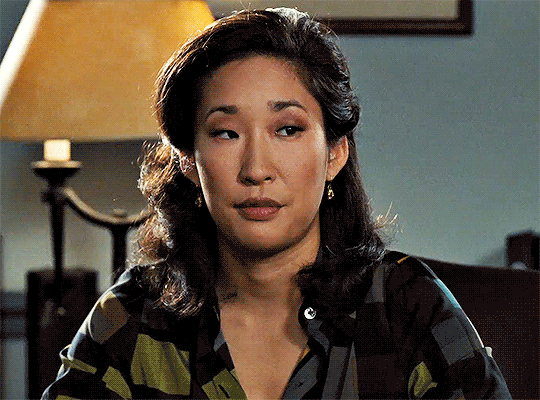
#Sandra Oh#Jodie Comer#Killing Eve#grey's anatomy#ellen pompeo#talent is not enough#rebel wilson#life's not fair#meritocracy is a myth
12 notes
·
View notes
Photo
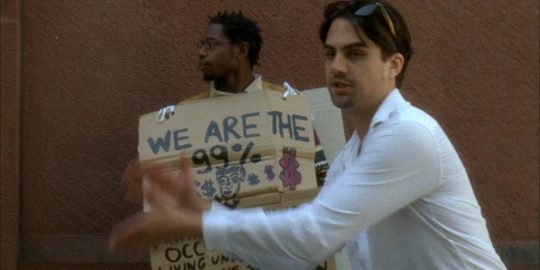
https://www.talkhouse.com/on-the-virtues-of-cinematic-failure/
///
Most journalists who have spoken to me about my new erotic drama PVT Chat (starring Peter Vack and Julia Fox and streaming now on most VOD platforms) assume it’s my first feature film. Actually, it’s my third. My first two features never played a single film festival and haven’t been seen by more than a few hundred people (mostly friends and/or curious followers of my rock band, Bodega). They were financial failures (even though they were made extremely cheaply), but you couldn’t call them critical failures because nobody has ever reviewed them. I spent the last decade working on these films and yet their cultural footprint is practically nonexistent.
Despite that, I still believe in them and hope one day I’ll make a movie (or record) that inspires people to seek them out. My early cinematic attempts certainly failed at behaving like normal movies, but to me it is precisely this failure that makes them interesting.
Godard said of Pierrot le Fou (1965), “It’s not really a film. It’s an attempt at a film.” This is a purposefully cryptic statement, but I think I understand what he meant. There is a sketch-like quality to his films from that period. He was less interested in following a particular plot through to its conclusion than suggesting narrative ideas and moving on. He enjoyed employing classical narrative tropes but didn’t want to waste screen time on the proper pacing required to sell those tropes to an audience. Instead he filled his screen time with spontaneous personal, poetic, and political ruminations that occurred to him literally on the day of filming. Many found – and still find – this approach infuriating, but for a select number of Godard disciples, like me, this type of filmmaking is still revolutionary. I remember seeing Weekend during my sophomore year of college at the University of South Carolina and having my mind completely ripped open. Suddenly the world wasn’t a small, mediocre, predictable place – it was full of music and color and philosophy and eroticism. There were people out there genuinely disgusted with the status quo and boldly proclaiming it with style.
Godard’s work is a fulfillment of the dream of the caméra-stylo – a term coined in 1948 by Alexandre Astruc that argued it was theoretically possible for someone to compose a film with as much direct personal expression as exists in prose. In order to achieve this level of expression, one often needs to move beyond the realm of mere plot and narrative naturalism, the principle that what you are seeing on screen is real. (On most movie sets, the filmmakers and actors work overtime to sell this illusion.) Films that focus solely on plot, character psychology, and one literary theme have to direct the majority of their screen time toward plotting mechanics and emotional manipulation of the audience. What you gain in dramatic catharsis you often lose in intellectual honesty. There’s always a tradeoff. I am invested in a cinema of the future that veers toward self-expression, but doesn’t need to avoid dramatic catharsis as Godard’s films did. Certainly many filmmakers my age are working to achieve such a synthesis of intellectual directness and narrative pleasure. Experimentation is required and many “bad” films need to be made to pave the way for future successes.
I graduated college in 2010 high on this dream of the caméra-stylo and philosophy (my field of study) and in 2011 started filming my first feature, Annunciation, with experimental filmmaker Simon Liu. Annunciation is an “adaptation” of the Mérode Altarpiece, an early Northern Renaissance oil painting triptych by Robert Campin. The film features three short separate narratives, one for each panel of the famous 15th-century painting. I wanted the performances in Annunciation to be controlled and somewhat surreal, as if the whole film existed in a heightened but slowed-down hypnotic state; I was thinking about Bresson, Ozu, Antonioni and, of course, Godard (particularly his work from the ’80s). There is some plot, but the main goal of the movie was to reveal the miracle of existence in the everyday. And because the Mérode Altarpiece depicts the scene in Christianity where the Virgin Mary was impregnated by light alone, the film had to be shot on 16mm film.
Now picture this: a 22-year-old walks into a conference room in Midtown Manhattan and gives this pitch to a producer who was then investing in thriller movies: “Every time light strikes a piece of celluloid, a miracle similar to the Annunciation scene occurs: an image appears in the likeness of man that redeems our fallen world and reveals it to be the beautiful place that we take for granted in our normal day-to-day.” This wasn’t met with the enthusiasm I was hoping for. “Don’t you see,” I said, “this is a film about the ecstatic of the quotidian! This is a film that audiences will flock to! It could do for Williamsburg and Bushwick what Breathless did for Paris!” Looking back, I am both shocked and charmed by my youthful naiveté, courage and idiocy.
I was laughed out of the room, but the producer was kind enough to wish me good luck and welcomed any future pitches, should I come up with something any “normal” person would want to watch. I never thought of films in the tradition of the caméra-stylo as being elite works only for the gallery or the Academy. I, like Godard before me, have always assumed that audiences are intelligent and long for thoughtful, challenging movies. That belief I carry to this day and thankfully it sometimes seems to be true. How else could you explain the recent success of heady films by Josephine Decker or Miranda July?
Thanks to small donations from family members (and credit cards), I was able to shoot Annunciation without any official backing. I cast the film with a mixture of non-actor friends and some undiscovered Backstage.com talent and dove head first into the production. Right as our principal photography began, Occupy Wall Street gained momentum, so Simon and I spent time at Zuccotti Park filming our actors experiencing the movement. The hopeful promise of OWS seemed to reflect the yearning desire of our film’s protagonists as well as our own idealist cinema experiment.
When the film was finished and edited, I naively assumed that we were well on our way towards global cinematic notoriety. Surely, I thought, this important film that manages to blend fiction with actual footage of OWS would premiere at Cannes or Berlin and the Criterion Collection would issue the DVD shortly after. In actuality, it was rejected from every single film festival we submitted to.
Undeterred, I conceded that maybe there were a few minor structural flaws in the edit. It was probably a little too long and perhaps the three separate narratives would work better if they were crosscut more. A year later, this new edit was again rejected from almost 100 festivals. Stubbornly, I thought that perhaps what could really bring the movie together was a comic voiceover by my then cinematic muse Nick Alden (who is a lead in both Annunciation and my second film, The Lion’s Den). Audiences seemed to ignore the comic tone underlying Annunciation. If only I could unearth it, they wouldn’t be put off by the pretensions to greatness the movie wore on its sleeve. There is nothing so offensive to American audiences as pretentiousness.
I didn’t send the overcooked voiceover version to festivals. I knew it was forced and worked against the core concept of the film. But it was then that I started for the first time to have doubts about Annunciation. Maybe my film wasn’t as emotional or clever as I imagined. Maybe it was bad? “No,” I decided. The film, whatever its flaws may be, has value. Herculean delusions of grandeur come in handy when you are trying to become an artist.
I opted to edit the film back to its original state, but without some of the weaker, obviously didactic moments, then hosted a few local screenings in NYC (most of them at DIY venues where my rock band would play) and put the film up for free on Vimeo. Around this time, it occurred to me that editing Annunciation had been my film school. Failure is a wonderful learning tool. Editing the same raw material in a myriad of different ways taught me about pacing and tone. Still to this day, when I find myself in a certain state of mind, I open up the Final Cut sessions and do a new edit of the footage just for fun, like some sort of DIY George Lucas tinkering with the past. Last year during quarantine, I did a new edit of Annunciation and uploaded it to Vimeo without telling a single person. It has become my own little cinematic sandbox to play in.
When people did chance upon one of my myriad edits, they often commented that they enjoyed its style but found the acting too unnatural. My response to this was to make my next film, The Lion’s Den, a cheaper HDV feature that doubled as a political farce and an essay about naturalism in cinema. The film is about a group of ding-dong radicals who kidnap a Wall Street banker and plan to donate his ransom money to UNICEF so salt pills can be provided for dehydrated children. The UNICEF plot was drawn from Living High and Letting Die, a 1996 work of moral philosophy by Peter K. Unger. It was both a serious attempt at political philosophy and a total slapstick farce; I was imagining the comedy of errors in Renoir’s The Rules of the Game mixed with the Marxist agitprop of Godard’s La Chinoise.
The acting style in The Lion’s Den was purposefully cartoonish; at no point in the film could an audience member believe that what they were seeing was real. I like to think that The Lion’s Den was an attempt at theatre for the camera, part Shakespeare and part Brecht. This was my own personal response to our epoch’s hyperrealism fetish. At the time, I believed that the current obsession with neo-neorealism, mumblecore and reality TV was worth combating. Art with a realistic aesthetic, I thought then, was inherently conservative and accepting of the political status quo (whether the artists were aware of this or not). Art with an imaginative anti-realistic aesthetic, so I thought, was utopian. It opened new vistas and ways of thinking and being. It dared to believe in a more beautiful world than the one we are living in.
The making of The Lion’s Den was extremely difficult. It was by far the hardest thing I have physically done in my life. At the time, I was malnourished and broke, not unlike the character of Jack in PVT Chat; my diet for that month we made the film consisted mostly of coffee, rice and beans, ramen, light beer, and the occasional waffle or fruit smoothie from the vegan frozen yogurt stall I worked at. Unlike Jack, my addiction wasn’t cam girls or internet gambling, but independent filmmaking. I begged, borrowed and scrimped $10,000 to make a film I knew I wouldn’t be able to sell. Despite having some key collaborators near the beginning of the shoot, most of the film was made with just me, the actors and a loyal boom operator, all living together in a house in Staten Island. This meant that I had to assemble all of the cumbersome lights for every setup, handle the art for every scene (which involved a lot of painting), block the scene and direct the actors, throw the camera on my shoulder and film, and then at the end of the day transfer the footage while logging the Screen Actors Guild reports and creating the call sheets for the next day’s scenes. Exhausted both mentally and physically, I often couldn’t stand up at the end of the day’s filming.
Once we’d wrapped and everyone had gone home, I stood in the middle of our set and played Beethoven on my headphones. Within seconds, I began bawling my eyes out, partly from exhaustion but also from the melancholy that all my friends had left and I was now alone for the first time in a month. I collapsed and slept for hours. When I woke up, it was my 26th birthday. I celebrated by watching Citizen Kane alone and then started the process of painting the walls back to a neutral white. The actor Kevin Moccia (who has been in all three of my films and actually works as a house painter) heroically came back to set and helped me. I told him that despite all of the agony of the past weeks (my bank account was now in the red, with overdraft fees piling up), I was happier than I had ever been. Working passionately on something that has great value to you is, without a doubt, the key to happiness.
Shortly after returning to the real world and my job at the vegan yogurt shop, I passed out while on the clock and was taken to a hospital by my very supportive girlfriend. Turns out, all I needed was an IV and some nutrients to get back on my feet, but unfortunately the trouble with The Lion’s Den had just begun. At some point, I formatted the production audio memory card and, in one instant, accidentally deleted everything on it. For the next two years, my friend Brian Goodheart and I worked with all of the actors to dub all of the dialogue and sound effects in the movie. Each actor had to completely re-do their verbal performance. It felt like remaking the entire movie. The result made the film especially un-naturalistic (which pleased me at the time) and it turned out far better than I think Brian and I expected.
By then, I had some hopes that The Lion’s Den could reach a small audience. It is aggressively philosophical but also features a love triangle, a car chase and a final shootout. Its comic style, I was hoping, would attract people who were put off by the purposeful flatness of Annunciation. Nevertheless, the movie was also rejected from every conceivable festival. I now realized that submitting an aggressively experimental narrative film without a single famous person in it to festivals is basically like flushing your money down the toilet. Yet I continued submitting, like an addict at a casino putting all of their savings on the roulette table. You never know, right?
In hindsight, I now see The Lion’s Den as a very angry film that perhaps uses comedy to soften the blow of some of its hotheaded fervor, and suspect some of its critique of capitalism and naturalism came from hurt and jealousy. “You think my work isn’t natural enough, eh? I’ll show you motherfuckers naturalism!”
Sometime in 2017, to my surprise I became smitten with certain neo-neorealist filmmakers (Joe Swanberg, in particular) and decided I wanted in on the mumblecore party, albeit from my own outsider perspective. I began to see how I could work symbolically with naturalistic performances, which led me to my latest film. PVT Chat is by no means a work of strict realism, but nevertheless focuses on believable dramatic performances. The film’s cast blends some actors from my past work (Kevin Moccia, Nikki Belfiglio, David White) with some heroes of the modern neo-neorealist indie cinema (Peter Vack, Julia Fox, Buddy Duress, Keith Poulson).
I want to end with a bit of advice to other filmmakers: Don’t put your self-worth into the hands of festival reviewers or distributors. The future of the moving image will belong to the films that are willing to risk cinematic failure. If you make an earnest film that doesn’t behave like a normal movie, I want to see it, even if it is full of technical or narrative mistakes (which it most likely will be). There’s no right way to make a movie. Follow the dream of the caméra-stylo and make a film that if nobody else made, wouldn’t exist.
5 notes
·
View notes
Text
Cranberry
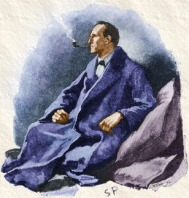
The ideal Holmes is tall and dark with sharp edges and an intelligent look to him, but also posh and with a sense that you could fold him into origami if you really tried. Dresses well, but wouldn’t look out of place sprawled dramatically over a couch in a dressing gown with a pipe and surrounded by drug paraphernalia. Once made a pillow fort and sat in it to think. Caught somewhere between handsome, pretty, and weird looking. Emphasis can be on any of the three. CANNOT have facial hair.
Holmes Adaptations
S-Tier

Miss Sherlock (Yuko Takeuchi) - 95%
You’ll notice, of course, that nowhere in the earlier description did I say Holmes needed to be white, a man, or even human. None of those qualifiers or the lack-thereof prevent someone from looking the part -- it simply becomes necessary to compare them to the characters around them. And when I picture a female Sherlock Holmes, Yuko Takeuchi embodies the exact image in my mind. Her sharp edges, piercing eyes, and impeccable fashion, along with the powerful weird energy she brings to the role, fit Sherlock perfectly. She does look more than a bit like she could kick my ass, but more in the manner she dominates the room, which is perfect for the character.
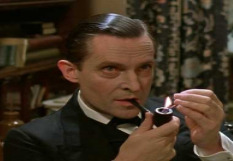
Sherlock Holmes (Jeremy Brett) - 85%
I haven’t watched this adaptation, though I’ve been meaning to get around to it. So this ranking is based solely on screenshots and promotional images. And honestly, as ugly as i find this guy, he totally nails it. He even kind of looks like the illustrations in the stories. I won’t give him a perfect score because his hair could be darker and his face is a little small, and there’s just barely something missing. But as far as “canon” Holmes adaptations go, he’s the cream of the crop.
A-Tier
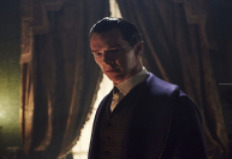
Sherlock: The Abominable Bride (Benedict Cumberbatch) - 80%
Definitely the more accurate of the two Cumberbatch Holmes designs, the sleek fashion and slicked back hair complement Cumberbatch’s angular build and “somewhere between pretty and just weird” face. He’s tall, dark, and posh. If there’s anything holding him back it’s simply that even dressed up properly, there’s something still a bit modern looking about him.
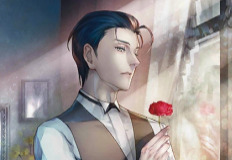
Fate/Grand Order - 78%
Given that his design and presentation are a direct reference to both Brett and Cumberbatch’s portrayals, it’s a given he’d place so highly. It’s really hard to nail down a 2D Holmes, especially in the anime style this game employs, since it has a tendency to prettify characters by default. True to form, FGO Holmes is far neater and more precise than I’d like. But he’s by no means a bad design, and depending on the image he can really hit the spot for me; he’s definitely a chart topper in the realm of 2D Holmes.
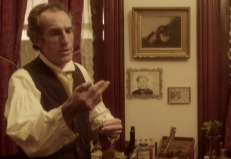
Sherlock Holmes: The Furtive Festivity (Gregory Johnstone) - 75%
There aren’t many Holmes that we only get to see as an old man, in no small part due to the ACD estate’s notoriously malicious copyright practices. Johnstone ranks so highly not due necessarily to the details of his look, but the overall feel he embodies. This Holmes is soft, affectionate, more than a little floppy. His hair and costume portray a man well grown into his eccentric life, and his face is sharp and mature enough to suggest the brains underneath; even if that’s more wisdom than intelligence in this particular story. This is a Holmes designed by someone who really loves Sherlock Holmes, and it definitely shows.
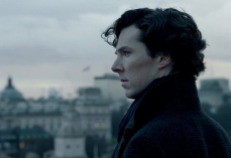
BBC Sherlock (Benedict Cumberbatch) - 75%
Cumberbatch’s features still naturally suit Holmes well, and he’s tall and striking enough to cover the rest. But this isn’t a rating of his acting performance aside from the visuals it supplies; it’s hard to modernize Holmes, especially since it makes perfect sense for Holmes to gel well with the changing times; he was always a man ahead of his era. BBC Holmes’s trademark trenchcoat and curly locks aren’t traditional Holmes, but they suit him well enough.
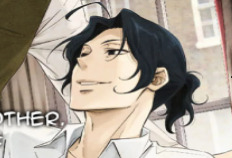
Yuukoku no Moriarty - 73%
The long hair is an unorthodox take, but I'm certainly not complaining. YnM's Holmes definitely nails the youthful scientific exuberance of an early Holmes. It's clear they were going for a sort of BBC/ACD mix, but with their own spin. Pretty -- he is an anime boy, after all -- but all sharp edges and full of energy. Decent, way better than most anime Holmes designs manage.
B-Tier
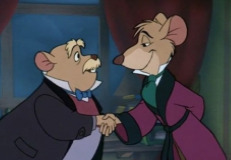
Basil of Baker Street [The Great Mouse Detective] - 70%
Comparing the character to those around them is especially important when it comes to non-human characters, who naturally don’t have the same features. Putting Basil next to Dawson makes this abundantly clear, as they make a perfect portrait of Holmes and Watson. For a mouse, he’s thin, angular, even a little ratlike; all decisions that suit Holmes well. I have some complaints about his ensemble, though; while the dressing gown suits him well, his normal brown coat and hat don’t work so well with his fur; the monochrome look makes him come off a bit scruffy and unrefined.
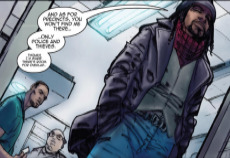
A Study in Black - 68%
Rules are made to be broken, they say; here’s a Holmes with well maintained facial hair and who’s shorter than Watson, and yet I can without question say they were the right decisions. This Holmes takes a very different design approach than any other on this list, even the other modern takes, but he embodies the spirit of Holmes much more than if he’d tried to match every detail. Holmes is still gaunt and striking, eccentric and fashionable. He looks absolutely great.
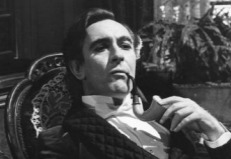
The Private Life of Sherlock Holmes (Robert Stephens) - 62%
Stephens in this role is, I have to say, far too soft. But he’s playing a different sort of Holmes, and I can’t resist keeping him here. There are some parts of the look he has down; he certainly looks high class, and the softer elements of Holmes’ character look good on him. Holmes’ traditional costume, the hat and coat, look out of place on him. But that suits the message of the film, and may very well have been intentional.
C-Tier
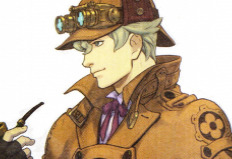
Dai Gyakuten Saiban - 58%
Not the only blond Holmes on this list, but it doesn’t suit him as poorly. From a character design standpoint, it looks very good. As a Holmes, it’s unorthodox. He’s not gonna be a chart topper with it, but I wouldn’t rule it out. This Holmes’ real problem isn’t his coloration, merely that he’s much too conventionally attractive. His jaw is a bit too wide, curls a bit too lovely, the peek of lavender under his coat a bit too rich, and I can’t look at him for too long without blushing. Do some cocaine and get back to me.
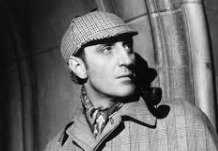
Sherlock Holmes (Basil Rathbone) - 55%
Now, this one might be controversial. I don’t think Rathbone Holmes looks very good. I can’t put my finger on why; his head is the right shape, his nose very sharp, though his face looks very smooth and he seems overall vaguely packed in. Like he was plucked out of the sky just before walking on set. The shapes are all right, it just seems off to me. I guess what I’m getting is that his look is too obviously produced. He looks too much like an actor portraying Holmes, rather than Holmes. But I know he’s gonna be the guy a lot of people swear by, so I won’t defend this placement too hard.
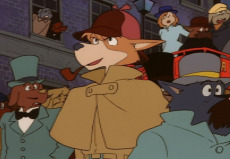
Sherlock Hound - 45%
Really, what is up with the monochrome design on some of these cartoons. Sherlock Hound has the darker hat to make up for it, though, so it’s a little better. Applying the same rubric as Basil to him... doesn’t get the same results. As far as I can tell, this just looks like a normal dog. And a scruffy light-furred one, at that. There’s a contrast between him and Watson, sure, but it could’ve been pushed further. At the end of the day this is an average guy dressed as Sherlock.
D-Tier

Herlock Sholmes [Code: Realize] - 40%
This is a very pretty anime boy. I’d pick him first in whatever dating sim this is. ...Wait, this is supposed to be Holmes? How can you tell? Look, I know it’s hard to make an anime boy Holmes. Holmes’ key design elements aren’t his costume or his hair, they’re the things that make him unpolished. And anime dating sim boys don’t like to be unpolished. But really, this is just a steampunk boy who likes tea. Nothing here reads as Holmes to me.

Sherlock Holmes (Robert Downey Jr.) - 35%
Now, I love this movie. RDJ got me back into Sherlock Holmes when I was younger. And as this character, he has a very specific and well designed look. ...Does that look gel with canon Holmes? I don’t think so. He’s rough, he’s scruffy, he’s short and wide and strong-jawed, and he refuses to go for a clean shave. I like him a lot, but he’s not very Holmesian. He does, however, nail the eccentricity and his costume design works for him well. I do like a messy Holmes. So I won’t go any lower than this.
F-Tier

Basil [Blush Blush] - 28%
So, he’s got the outfit. There’s that. But otherwise... This is just some soft ugly anime boy cosplaying Sherlock Holmes. He doesn’t have a single trait that works in his favor. On top of that, he’s got the same problem the other Basil on this list had -- the all monochrome light brown just looks weird, and not Holmesian at all. And this boy doesn’t have the excuse of literally being a mouse. This is just an ugly design.

Elementary (Jonny Lee Miller) - 25%
Now, I've only watched a few scattered episodes of Elementary. Partially because I'm morally opposed to shows that only gender-flip half of the duo, partially because I’m absolutely outraged by the travesty they made Moriarty. But this isn’t a bad character, per-se.
But, like, this is just some dude. This isn't Holmes.
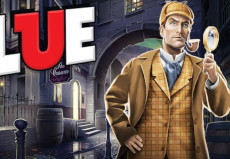
Sherlock Holmes [Clue] - 23%
I love Clue so much. That probably doesn’t surprise anyone. I have the season pass in this game, which automatically gives me every DLC character they add for free. So I was super excited to hear there was gonna be a Sherlock crossover. ...But this is just ugly. Another light haired square-jawed monochrome asshole pretending to be my favorite character. There’s nothing Holmes about this. (The rest of the designs in the pack are no better, but this isn’t about them.)
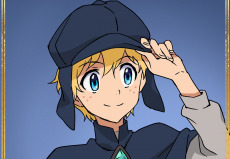
Skylar Holmes [Blossom Detective Holmes] - 20%
Now, Blossom Detective is a show that I famously disliked so much I immediately sat down and screenwrote my own Holmes cartoon on the spot. And Skylar certainly feels like she should be in the “part 2″ of this list, but a Holmes she is.
She's cute and she accessorizes well, but she's just not Sherlock Holmes by any stretch.

Sherlock Shellingford [Milky Holmes] - 10%
Now, look how cute she is! Sherlock Shellingford, present and accounted for. She’s got TWO Sherlock names so you know she’s the real deal. Now, this is just an objectively good design. She's exactly what she needs to be to serve the role she plays!
And that isn't Sherlock Holmes. Sorry.
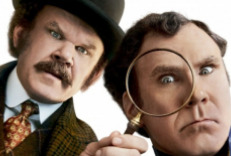
Holmes & Watson (Will Ferrell) - 0%
Get out of my house.
Holmes Archetypes
Not all Holmes’ are meant to be the Canonical Sherlock Holmes, of course; some are just neat references, or characters who naturally fit into his role whether the author intended it or not. Let’s address them here, and remember that not looking the part doesn’t really reflect negatively on these ones as they’re stand-alone.
S-Tier

Dylan Reinhart [Instinct] (Alan Cumming) - 90%
Dylan is so point for point Sherlock Holmes that it’s hard to call him an archetype and not a straight adaptation, or possibly a rip-off if I’m being harsh. But I’m not supposed to be rating him by portrayal, just looks - and he’s really good. He’s the exact right blend of weird looking, though not as angular as he should be. His sharp eyebrows and nose and high hairline work fantastic, and he wears a suit very well. He’s a perfect little bundle of posh and nerves, and though he’s not perfect the fact that this isn’t actually supposed to be canon Sherlock Holmes makes this placement very unsurprising. He wouldn’t look out of place on the other list.
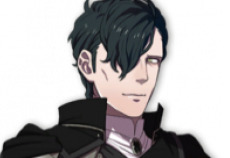
Hubert von Vestra [Fire Emblem: Three Houses] - 85%
Oh? What’s that? You don’t think Hubert von Vestra is a Sherlock Holmes archetype? Okay, then explain to me why he uses the word “sentiment” exactly twice in his supports. Atheists 1, Church of Seiros 0. Anyway. Let’s start with the obvious. Hubert looks like Benedict Cumberbatch. But, he looks like a vampire Benedict Cumberbatch who did a lot more cocaine. And if you don’t think Sherlock Holmes should look like a vampire, youre lying.
A-Tier
None yet. Please submit your Holmes and I will add them.
B-Tier

Heinwald [Dragalia Lost] - 67%
I would never look at this design and think "well, that's Sherlock Holmes". Heinwald looks more like a zombie or the bride of Frankenstein, very Halloween. His look being so specific does come at the expense of his Holmesness, but he's still got more than a few traits down and he’s an absolute treat.

L Lawliet [Death Note] - 65%
This is a very, very weird looking man. Key points: dark hair and eyes. gaunt, sharp, and mostly angular (though with a softer face). Extremely foldable. This man could 100% pass for Holmes, if someone else was dressing him. Put him in a suit, comb his hair? Yeah. It’d really work. But until then, he’s just most of the way there.

Kyoko Kirigiri [Danganronpa] - 63%
Kirigiri really gets jilted here, because she could be much higher. Unfortunately, she has to be part of a series that with only a few exceptions just reuses the same face and body for most of its female characters. Kirigiri definitely has the sharp and focused feel she needs to pass for Holmes, and she dresses well. The white hair is the opposite of the dark he usually touts, but it’s striking. Unfortunately, put her next to any other character in her series, and she blends back in.

Miles Edgeworth [Ace Attorney] - 60%
Feels a little weird to put Edgeworth on here when the actual Sherlock Holmes is in his game, but he fits the character much better if not the narrative role. So let’s go over the looks. His jaw is a bit wide, but he’s very pointy, and I certainly have never gotten the impression he’s a physically strong man. He’s very fashionable, and with his big cravat and sharp hair he makes a cutting silhouette. I’d say he needs a bit more to really nail the look, though.
C-Tier
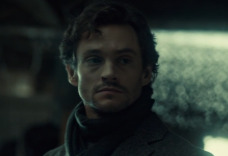
Will Graham [Hannibal] (Hugh Dancy) - 45%
Despite being a noted Hannibal Lecter fan and possible homosexual, I still haven’t watched Hannibal. I’m taking people at their word that Will is a Sherlock; I definitely would have assumed otherwise looking at him. He reminds me deeply of BBC’s John Watson, and it’s hard to see anything else. But I don’t hate his look; he reads as clever, he looks good in darks, and I wouldn’t complain to see him cast as Holmes. He’s better than some of the lower-tiered canon Holmes actors, anyway.
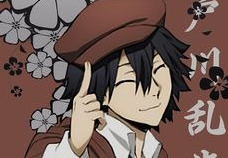
Ranpo Edogawa [Bungo Stray Dogs] - 40%
This is another submission, and I don’t know who this boy is. I really doubt he’s actually a Holmes, given that he’s named after a real non-Doyle writer, but I was begged to include him. Let’s go. I really like his outfit. He’s got an aesthetic I like. Is it Holmes’? No. This kid looks like he’d fit way better as a Baker Street Irregular; maybe he should audition.
D-Tier
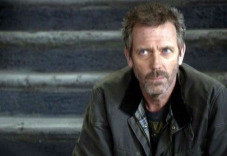
Gregory House (Hugh Laurie) - 35%
Take everything I said for Robert Downey Jr, and just mess up his hair a bit more. House is scruffy, poorly put together, and not wearing anything that costs over $100. As a Holmes, he’d work as one of his disguises; I wouldn’t be super surprised if this guy suddenly cleaned up and looked the part -- but it would take a lot of cleaning. I love his look, though -- again, he isn’t trying to be canon. House is an explicit Holmes parallel, but he’s still his own character.
F-Tier

Walnut Cookie [Cookie Run] - 20%
Given how much “Holmes costume” and “Detective costume” are conflated, it’s possible this gingerbread baby isn’t even supposed to be a Holmes reference, but I’ll take her. She’s an excellent design - but a standalone one. Shes too soft, warm, and curly looking to pull off canon Holmes.
6 notes
·
View notes
Text
The Lost Special?
Musings over possible implications of BBC Dracula
After obsessively watching all three episodes of BBC Dracula, I can’t help feeling I’ve got one of my suspicions, if not exactly confirmed, at least enhanced: that this Victorian old story, finally adapted into present time, might in fact be relevant to Mofftiss’ version of ACD’s short story The Lost Special. Maybe it is, maybe it isn’t, but since I can’t deny I do like ‘tin-hatting’, for now I choose to believe it is. ;)
(Continued under the cut)
As some of you guys already have expressed, I think BBC Dracula has BBC Sherlock written all over it. I believe this was obvious already from the setup; same authors, same producers, same broadcasters, same set designer, same format, three of the same actors including one of the writers, and even the same airing slot as BBC Sherlock. The Sherlock hints are sprinkled all over the two first episodes, which occur in the same Victorian time frame as ACD’s original Sherlock Holmes stories. This for example:


But the bringing of Bram Stoker’s old narrative into present time in the third episode (The Dark Compass) kind of sealed the deal for me.
Suddenly we have Count Dracula sending text messages by smart phone to his victims:
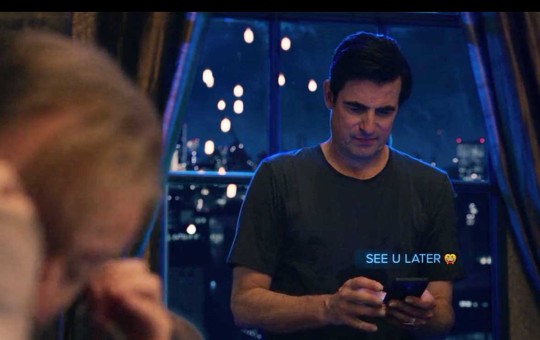

We have Dracula vomiting on the rug of a crime scene:

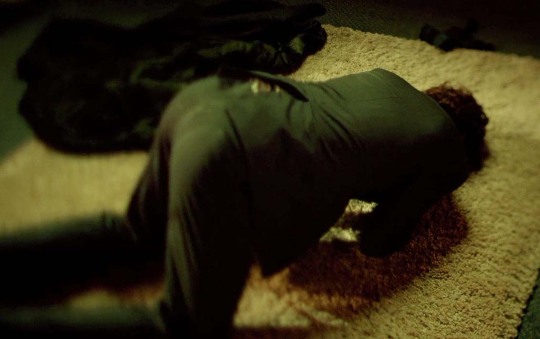
We have him storing body parts in the fridge! (X)
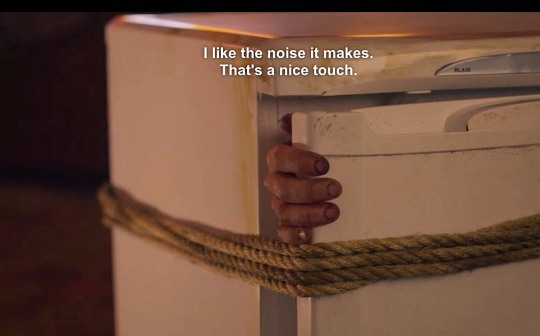
And this fridge scene is taking place while Dracula is watching a TV program with elephants on the Savannah, exclaiming “Look at her - so beautiful!”:
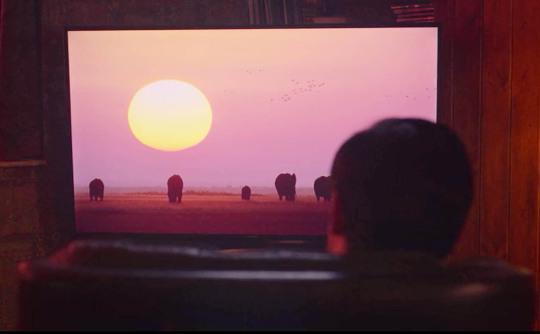
Who is beautiful - the ‘Elephant in the Room’? It certainly feels like Mofftiss are stringing us along here, doesn’t it? ;)) But no; it’s the sun that Dracula admires as beautiful, we learn that in the show. The shining from the sun is a thing he thought he could never endure, but ultimately he learns that he actually can.
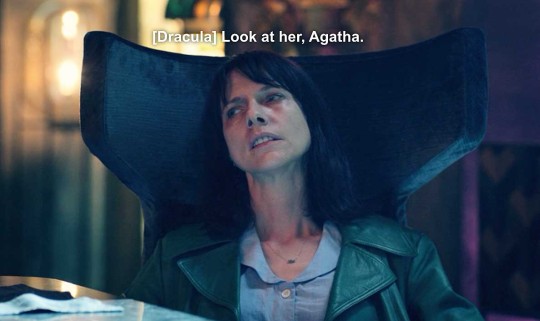
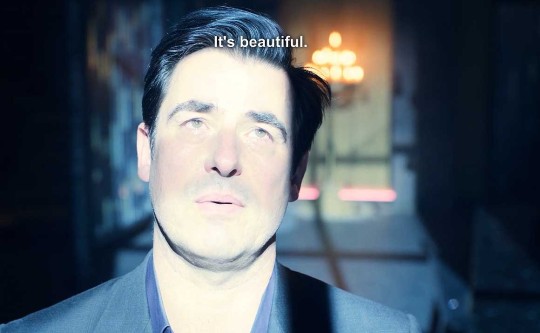
Same thing as Sherlock says about John Watson the distant suns in the sky in TGG:

Or about Sister Sentiment’s music in TFP:
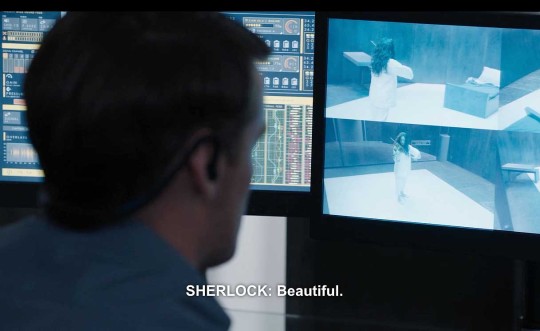

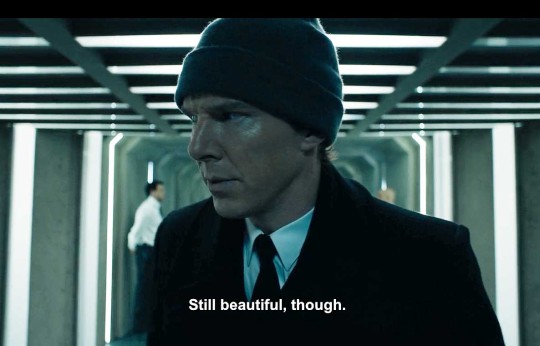
Taking Dracula to modern time is something that the authors had expressly denied they would do. But they were lying of course, as is their usual MO. Exactly the same deception as they did with TAB, isn’t it? And as if this wouldn’t be enough, there’s a whole list of other modern Sherlock references, summarized by @gosherlocked (X). I’m sure there’s more, we just need some more time to find them.
As I mentioned in this comment recently (X): The Lost Special (X) is a short story about a derailed, disappeared train that ACD wrote during the Great Hiatus (1898). It bears some typical Holmes-case mystery characteristics. And the anonymous person who in this story sends a letter to the train company, suggesting a way of solving the case, seems very much to be Holmes himself:
“It is one of the elementary principles of practical reasoning, that when the impossible has been eliminated the residuum, HOWEVER IMPROBABLE, must contain the truth. It is certain that the train left Kenyon Junction. It is certain that it did not reach Barton Moss. It is in the highest degree unlikely, but still possible, that it may have taken one of the seven available side lines. It is obviously impossible for a train to run where there are no rails, and, therefore, we may reduce our improbables to the three open lines, namely the Carnstock Iron Works, the Big Ben, and the Perseverance.”

(X). So this short story indeed looks like a Holmes story in disguise. But Sherlock Holmes’ name is never mentioned in The Lost Special and the storyteller is not John Watson. In this story the police did not act on this anonymous person’s advice. The truth wasn’t revealed until one of the perpetrators - a hired murderer who was threatened with execution years later - admitted that he had participated in derailing the train in question (X): “A conspiracy of men had temporarily re-attached the side track leading to the abandoned mine Heartsease just long enough for the train to go down to the mine, then pulled the tracks back up before they could be discovered.” To the broader audience, however - the Holmes readers - the character of Sherlock Holmes remained ‘dead’.
The wrapping up
One could say that The Lost Special both had and had not a satisfactory ending. Satisfactory because the truth was finally told and the mystery thus solved, but unsatisfactory because in spite of all the hints, the readers didn’t get to know anything more from Holmes. Not until years later (1903) when ACD actually did ‘resurrect’ him and continued the narrative of Sherlock Holmes with 33 more short stories.
When Dracula finally ‘dies’ at the end of the BBC Dracula series, it’s not by being ‘staked’ or burnt to ashes with the sunlight as one would expect for a ‘monster’ like him. It’s by embracing the criticism of his most resilient but dying opponent: Zoe/Agatha Van Helsing (Mofftiss call her ‘Zagatha’ in an interview). She is dying from cancer, not from vampire bites. Dracula drinks her (to him) mortal blood and then ‘dies’ in her arms, basking in the sunlight (without burning) in a tender lovers’ embrace.

Zagatha in BBC Dracula is criticizing the vampire for skulking in the shadows, being afraid of facing death. She says it will be his punishment to live on for eternity, while she is mortal and dying:
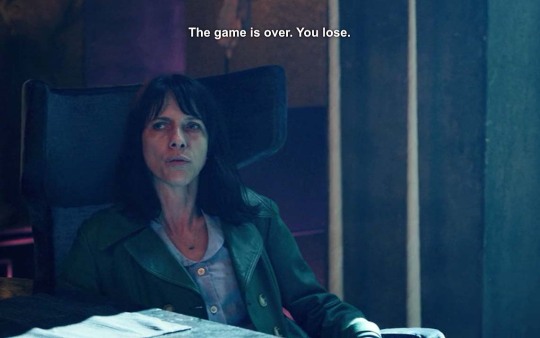
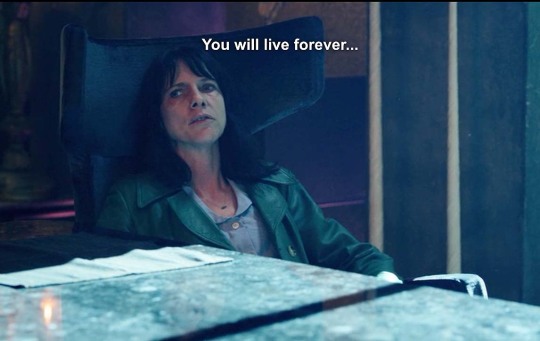
Seriously, this is so much ‘Buffy the Vampire Slayer that I can’t just... But Count Dracula re-writes Bram Stoker’s original story and opts for another solution: to ‘die’ willingly in the sunlight, together with Zagatha. And if dying is a metaphor for falling in love - as I believe it is in BBC Sherlock - this might have some important implications. I think Dracula and Zagatha here represent two sides of Sherlock that are finally allowed to merge; his Sentiment and his (Homo)sexuality.
Like The Lost Special, BBC Dracula is nicely wrapped up and ‘solved’. But we still don’t really know what happened with Count Dracula, because we don’t actually see him crumble into ashes like he did in Stoker’s canon, and like the other vampire who was ‘staked’ in the show - Lucy Westenra. But the episode is packed with Sherlock references, so...
But I can’t say for the life of me that S4 of BBC Sherlock brought a satisfactory ending for the Holmes narrative either; it’s not ‘wrapped up’ at all! John and Sherlock seem to live on for eternity as ‘best friends’, solving crimes in the heteronormative ‘legends’ preferred by Ghost!Mary’s voiceover. They are simply immortal, Un-Dead for ever - like a punishment? Wouldn’t it be far more satisfying if Sherlock Holmes and John Watson’s characters would come out and appear ‘human’ and ‘mortal’ and not have to remain just ‘best friends’ forever?
The (lack of) train references
One might argue, of course, that there are no specific train references in BBC Dracula, so how could we think it has anything to do with The Lost Special? Because, like The Lost Special, BBC Dracula is a Sherlock story in disguise! And because in the BBC Sherlock narrative itself there are already several episodes with train references; the most prominent of them is TEH and the last one - TFP. So there’s really no need for more references. But the train theme isn’t explained; it’s not ‘wrapped up’ at all, and neither is Sherlock’s story. I’ve tried to argue before that the detective is actually dying in S4, and so have others (X). And making him immortal will not save his credibility as a human.
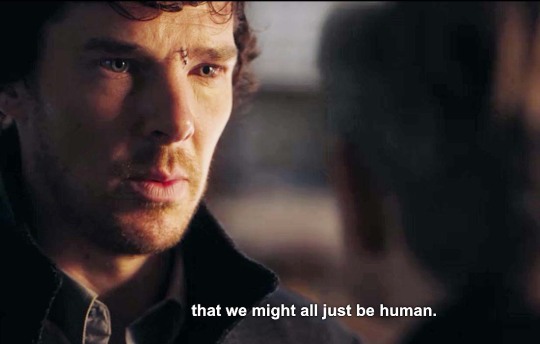
I do hope he’ll wake up again, though - preferably with help of modern medicine rather than superstition - to a more credible and realistic story than both TFP and Dracula. ;)
In TEH, apart from scenes with John Watson traveling alone through the Underground network of London, we have a derailed Underground train carriage near Sumatra road, where no-one would care to look. Like a Lost Special. It’s not carrying a bomb; the whole carriage is the bomb, which is threatening to overthrow the Parliament. Which very much makes me think that Mofftiss still have a metaphoric ‘bomb’ stored for us, a ‘rug-pull’ of sorts. But John and Sherlock (and the world) were not ready in TEH, so they switched it off. The ‘bomb’ never went off in S3 (2014). In TEH John was urging Sherlock to ”use your Mind Palace” to defuse the bomb, and I think he did - for the rest of the show up until TFP. Because in TEH, Instead of the big explosion, we got a truly weird, staged scene with Anderson (who didn’t quite believe Sherlock’s explanation anyway).
And then the plot carried on in its heteronormative tracks with John’s wedding and Mary taking over the narrative. But in TST we learned that Sherlock, as a child, had re-written an old tale about someone encountering Death in ‘Samarra’ into a story where the hero ends up in Sumatra instead, and lives. In TFP the plot derailed completely into an absurd horror story, and we got Moriarty as train driver, going “Choo-choo!” like a train whistle:
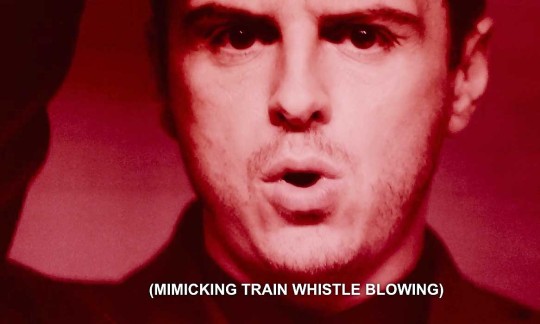
But the only 'explanation’ related to trains that we learn about Moriarty in TFP is rather lame: that Jim’s brother supposedly was a station master (not from canon, though). And then he goes “tick-tock, tick-tock” like a ticking bomb:
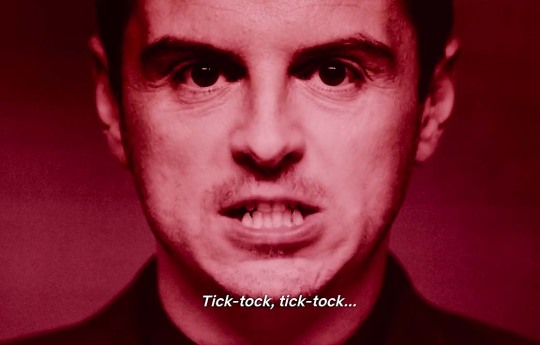
(Also similar to Mycroft’s ‘tick-tock’ countdown until he’ll die from obesity in TAB). But no bomb went off at that point in TFP either (I’m not counting the Patience Grenade here, because that happened before the ‘tick-tock’). So what was all that tick-tocking about? And how long will it keep ticking asdf?
The Sussex Vampire etc.
After reading some interesting metas from @yeah-oh-shit (X, X) and @ebaeschnbliah (X) I feel more and more convinced that legal issues with the ACD Estate might be very relevant for what Mofftiss are doing with BBC Sherlock and BBC Dracula. Three important ACD stories have now entered the public domain on January 1st this year: The Sussex Vampire (SUSS), The Illustrious Client (ILLU, where Holmes and Watson visit a turkish bath ;) ) and The Three Garridebs (3GAR; known for a scene where Holmes shows a glimpse of his true feelings for Watson). in SUSS there’s a quote about Sumatra which I find really interesting in the context described above:
“Matilda Briggs was not the name of a young woman, Watson,” said Holmes in a reminiscent voice. “It was a ship which is associated with the giant rat of Sumatra, a story for which the world is not yet prepared.
As I said in this comment (X), there’s a lot of subtext to draw from this. And I do hope the world is prepared now. ;)
@raggedyblue @ebaeschnbliah @gosherlocked
79 notes
·
View notes
Note
When MVA/MLA Arc gets animated, what will you be looking forward to the most? What (canon-compliant) additions and/or changed do you want or think Bones should make, if any?
There’s--a lot. Does that surprise anyone? There’s a lot.
o I have been foaming at the mouth for voice actor announcements for almost a year now, particularly for Trumpet, Geten and RD.
Trumpet’s superpower is literally his voice! I mean, nothing about that statement requires that voice be particularly entrancing, but it certainly seems like it should be, right??
Geten is a boku-type in the manga, but that was literally the only hint foreshadowing his pretty boy face through 21 solid chapters of Pure Feral Gremlin. Everyone was shocked by Geten’s face reveal! How do you maintain that surprise value with an actual voice actor in the mix? Do you not even try? Do you play up the disparity--in which direction? I can’t wait to see what they do.
And Re-Destro! Re-Destro requires so much range! From his peppy, silly businessman persona, to the urbane commander, from the overeager yes-man to the raving zealot--who on earth do you get to believably cover all that ground? I can’t even begin to guess, but I am living in anticipation of that article going up on ANN or the official Twitter sources.
o I’m also much looking forward to getting official coloring on Trumpet and Geten. Skeptic seems pretty straightforward--black, black, more black--and RD and Curious, we have color art for, but I wonder if Trumpet will also be all black clothes, to go with that dignified politician image of his, or if he’ll get some color to pep him up a little. What color are those tinted shades of his? His eyes? The wicked-cool Sevens Loud?
I assume Geten is all wintery shades, but it’ll be great to confirm which ones. I mean, we all assume he’s white-haired to better annoy Dabi with family parallels, but what if he turns out to be platinum blond? And are his eyes blue? Gray? White? What color is that awful parka?
Also, Re-Destro’s stress powers. Having been writing them as black since at least August--Rorschach test blots are generally black, after all, and they’re the clear inspiration--I would much like it if the anime would have my back on this. They made Destro’s mask a dark cinnamon brown, though, so I’m prepared to be unpleasantly surprised in this matter.
o Predictable MLA adaptational choices aside, I’m also eager/anxious about how they’ll handle Spinner’s narration. What I really hope is that they actually straight-up hand him ALL the narration duties--not just the stuff he dictates directly in the manga, but also e.g. the name and quirk explanation material that Present Mic normally gets, or the previews that are always handled by Deku.
The opening and closing sequences are another big structural thing, of course--based on the flashed snippets of Hawks and Endeavor in both our current and the previous OP, I’m expecting we’ll see at least a bit of something referencing the upcoming internship arc (which I expect to close out the season), but I hope the villains just walk away with the closing entirely. I want my slice of life villainy ED, dangit.
o Another thing I’m eager/anxious about would be Kotarou, and the Shimura flashback generally. There’s a brittle edge of to Kotarou that I really love, and I hope he manages to keep it in the anime, despite the anime being generally not so great at moments that I would describe as “delicate.” For example, I’d like it if he doesn’t get a super deep voice, and if they could manage to keep his pretty face, and capture how deeply bitter and tired he looks in the scene where he’s reading the letter Nana left him.
Also, I hope they keep the little montage bits and, crucially, the changes of clothes the family goes through. We see Tenko in no less than five, possibly as many as seven, different T-shirts through the course of that flashback. It seems like a small thing, but it’s one of the factors that makes me skeptical that AFO gave Tenko Decay, when so many days clearly go by between the opening with the man at the door and the tragic end. It’d be nice not to see too much resurgence on that just because the anime can’t be bothered to come up with more than one outfit for the Shimuras.
I have enough issues with the anime’s usual adaptation choices that I’m trying not to get my hopes up too high on the actual content of the episodes. The staff is diverting too much of its major talent to the movies (BAH) these days for me to expect the whole season to look all that great, and it’s never been particularly creative or daring outside of its climactic sakuga-heavy fight scenes anyway. I’ve also long had a bone to pick with its scoring decisions, and am already eyeballing the climax of the RD/Shigaraki fight and imagining the minor-keyed terrifying dirge I fear the anime will play there, at the moment that Re-Destro (and, shortly afterward, Spinner) are supposed to be experiencing something akin to religious awakenings.
There’s also the issue of the violence and gore--judging by how the anime handled the scene where Shigaraki and Compress maim Overhaul, I have some severe reservations about how much blood they’ll be allowed to get away with, particularly in the scene where the League brutally decimates that CRC group and, of course, Shigaraki’s backstory. I’m looking at MVA to serve as a preview for how all the same issues will be addressed in the War Arc.
That bit of pessimism aside, as to what I’m hoping they’ll add or change? Well, off the top of my head.....
o I would love to get a full episode devoted to the time the League spends fighting Machia. Not that first tussle, but the six grueling weeks in the mountains. There’s so much you could add there for character building and atmosphere that Hori didn’t so much as montage through. Where was their food coming from? How’d they pick out places to pitch camp? How much access to news from outside did they have, and how frequently? What were the circumstances in which Gigantomachia “told them himself” about his great sense of smell?? Stuff like that!
I don’t think we’re at all likely to get this--honestly, the series of late has had enough of a problem with trimming bits and pieces that I’m as worried about what they might cut as I am hyped about things they might add--but the one thing that gives me some hope is the training camp arc. Specifically, the moment 1-A first gets to the Pussycats’ forest, they get jumped by earth golems, a fight that the manga off-panels entirely, but the anime spends a modest amount of time on, giving the kids a little bit of time to show off their moves and such. I’d love to get something equivalent for the League.
o On a similar note, I wouldn’t turn it down if they fleshed out some of those running street fights a bit. One obvious thing comes to mind: there’s a weird jump in the manga between Skeptic and a horde of his golems being all but on top of Twice at the beginning of 233 and then that fight just--doesn’t happen. There’s no mention of it at all. I think the suggestion is that either Machia’s appearance or the tower going down interrupted it--Skeptic breaks off from his fight the same way Geten and Trumpet do theirs, shifting focus to protecting Re-Destro--but it’d be nice to see the anime touch on it.
o It’d be nice to get a bit of expansion on the nature of the bullying Spinner endured. We’re told he was, but was it limited to verbal? Did he get beaten up a lot? Was there an online element? Deku’s our only other reference point for “bullied kid,” and whatever one might think about the story’s development of Bakugou’s mentality, it’s been made clear in retrospect that there was a lot more too that than just the matter of Deku’s quirklessness. I’d love to know how Spinner’s bullying looked in comparison (not least because of some of the theories about Spinner and Deku needing to come to some kind of accord to free Shigaraki from AFO).
o Make the Villa (both here and during the War Arc) look more realistic. By which I mean, I know Horikoshi is capable of drawing interesting and lived-in interior spaces--he has an entire chapter dedicated to it in the 1-A dorm room contest, after all--but he normally doesn’t bother much with it. At UA, it’s not too distracting, because we know good and well that that whole building is probably maintained by Cementoss anyway. Ditto places like Tartarus (intentionally, dehumanizingly barren) or the League’s post-Kamino hideouts (abandoned homes and industrial spaces). But the Villa?
For heaven’s sake, it’s called a mountain villa. It has a clear reception desk on the ground floor; it’s obviously some sort of high-end hotel, if not an outright resort or rentable retreat lodge. Speaking as someone who’s worked in one, places like that don’t look as fuckin’ bare as the rooms we see there always seem to. For fanfic purposes, I’m happy to go on telling myself that e.g. the pool and the bar and the restaurant(s) and the gym are in the building Cementoss doesn’t tear in half, but it’d be nice if the anime could class the whole place up a little, maybe put some real furniture and decor in the rooms that are in use. (Yes, I know this is a ridiculous nitpick.)
o This is less a change and more a correction, but for fuck’s sake, BONES, give us white-haired Shigaraki. The climax of Deika is a solid time for it, given that it’s obvious in the manga that Shigaraki’s hair gets paler in Deika--you can see it in the way Horikoshi inks it (which is to say, the way he stops inking it)! I think if we ever get white-haired Shigaraki in the anime, a somewhat better time as far as narrative justification goes would be when Shigaraki gets out of the tube in the War Arc; you could easily justify it as a side-effect of the surgery. Still, I’d rather see it here. I want white-haired Shigaraki, gleaming and brilliant through the scattering ash in that crater, a veritable angel of sacred destruction.
Honestly, more than anything, the crater sequence is the one I hope I love. It’s probably my favorite single moment in the entire manga, as Shigaraki wins over Re-Destro, Spinner and Gigantomachia in the same moment, and finally comes into his own. If they can at least nail that, I’ll consider myself pretty satisfied.
#stillness-answers#my villain academia#meta liberation army#boku no hero academia#bnha#hopes and dreams
15 notes
·
View notes
Text
Inside the Mortal Kombat Movie’s Bloody Love Letter to Martial Arts
https://ift.tt/3sPd50L
About 10 hours into a November 2019 flight to Australia and the set of Warner Bros. Mortal Kombat reboot, I started to ask myself whether this was all worth it. I loved the original Mortal Kombat movie about as much as anyone unironically can, but the fact remains that the history of live-action video game film adaptations is paved with disappointment. Even the best movies in that field have earned their reputation largely by exceeding low expectations.
After nearly 30 years of failed attempts, it’s hard to even picture what a good live-action video game movie might look like. What is it about the transition from sprites to screen that makes this process so difficult? Is this a pursuit that is, in some ways, doomed to be dictated by those who see such films as another piece of merchandise? What will it take to finally break the curse? Those questions raced through my jetlagged brain as I finally made it to Adelaide and prepared to see what awaited me on the other side of the world.
Shortly into my visit, I was taken off my feet by a line that hit me like an MK player mercilessly spamming a leg sweep. It came in the form of this line from producer Todd Garner that reshaped my expectations and set the tone for what proved to be something that was very much worth the trip and perhaps worthy of your own wait:
“I think it’s great that there are a lot of characters, a lot of lore, and let’s do it all well. But really, people want to fuck each other up.”
Gore and Lore
Garner was, of course, mostly joking. Yet, there is a truth in many jokes, and the truth in this one seemed to be that managing what the Mortal Kombat canon has become can be a daunting task. It’s certainly not made any easier by the fact that there haven’t been many undisputedly great video game movies for the team to work with and use as precedent.
In lieu of notable live-action video game adaptations that made good on their ambition, the film’s production team turned to a source that most would agree has.
“It’s like the Marvel Universe…it’s endless,” says Garner of the Mortal Kombat game franchise. “So we started from the premise ‘What would Marvel do?’”
It’s a useful question that the upcoming Mortal Kombat movie answers in fascinating ways. For instance, as Garner noted, the MCU didn’t start with The Avengers; it started with Iron Man. That film allowed Marvel Studios to ease viewers into a project that was, in its own ways, also somewhat unprecedented. Similarly, the Mortal Kombat movie uses the character of Cole Young as a kind of audience surrogate. He’s a new face in this universe who is also trying to figure all of this out.
It’s all part of a delicate balancing act that requires the cast and crew to constantly ask themselves how this movie looks to a diehard fan and how it will look to someone who is just coming into this.
“There are five million people that play this game religiously, but there are 100s of millions of people in the world,” Garner says. “We didn’t want the other 95 million people to go, ‘What the fuck is this. What is this tone, what the fuck is happening?’”
It’s easy to understand how fans could quickly become overwhelmed. If you haven’t played the more recent Mortal Kombat games, you may be surprised to learn that they’ve adopted a complex serial storytelling narrative that combines years of mythology as well as the events of the most recent games. If you tried jumping into Mortal Kombat 11’s interdimensional, time-jumping story, without at least an explainer of what came before, you’d probably think it was madness. Amusing madness, perhaps, but madness nonetheless.
As it turns out, even Mortal Kombat director Simon McQuoid had a lot of catching up to do.
“I feel like I went to Mortal Kombat university,” says McQuoid regarding the experience of learning the intricacies of the franchise. “I also surrounded myself with a lot of people who know a lot more about this than me.”
In the same way that 1995’s Mortal Kombat benefited from director Paul W.S. Anderson seeking and utilizing fan and crew feedback, McQuoid’s own desire to surround himself with lifelong MK fans is just one of the ways that the crew is determined to ensure they don’t make the mistake others have before them by straying too far from the desires of those who helped make the Mortal Kombat franchise worthy of adaptation in the first place. His efforts ultimately come down to honoring an important word.
“The word I use a lot is ‘respect,’” says McQuoid. “Respect for the fans, respect for the characters, and respect for the canon. The execution ultimately takes that into consideration from the absolute bedrock of listening to and understanding the fans.”
Read more
Games
Mortal Kombat: The Definitive Video Game Movie of the ’90s
By Matthew Byrd
Games
Mortal Kombat Characters Ranked
By Gavin Jasper
Of course, as Garner previously eloquently noted, what many Mortal Kombat fans are looking for is over-the-top violence executed with flair. That is a big part of what made the original Mortal Kombat stand out in a crowded arcade scene, and it is certainly one of the qualities that have stayed with the series as it has evolved into this surprising vehicle for complex narratives and diverse characters.
Fatality!
Of course, you can’t talk about Mortal Kombat violence without coming around to fatalities. What began as now strangely humble decapitations and spine extractions has evolved into a bloody ballet of highly choreographed violent ends that account for the lore and ability of every character. It’s something that was largely missing from the 1995 adaptation, and it’s something that Garner admits can be tricky to get right.
“There’s crazy shit you can do in the game,” Garner says. “The problem with the fatalities, in general, is…I’m under the restrictions of the Motion Picture Association of America so I have to live inside those rules.”
In case you haven’t seen the recently released trailer, let me assure you now that the MPAA has not scared the team away from incorporating fatalities and MK’s other, bloodiest elements. In fact, McQuoid is practically at sea with the amount of blood on set.
“I don’t know the gallon number, but I’ve seen drums of blood sitting around,” McQuoid informs his audience of gorehounds with a smile.
So yes, there will be blood and lots of it in the Mortal Kombat reboot, but the team isn’t relying on the presence of blood alone to fulfill their equally important mission of telling a Mortal Kombat story as compelling as the ones featured in the games. Actually, they recognize that there are times when extreme amounts of violence can work against the dark tones that help make the franchise’s universe so compelling.
“When I wanted a serious moment I didn’t want it to get comedic because we’re swashing blood,” McQuoid says. “It’s a tonal thing…you really need to feel it all instead of having people say ‘Oh, that’s funny.’”
Besides, there are other ways to convey the series’ violent nature and brutal style that doesn’t necessarily require a drum of blood. From the first game in the franchise, Mortal Kombat has nodded to at least the cinematic history of martial arts. Whereas that series initially struggled to convey the fluidity and complexity of the best martial arts fights, though, the MK movie team has set a high bar for themselves.
“The first thing I said to [stunt coordinator Kyle Gardiner] was “Okay, Kyle, you have to make the best fights that have ever been on film,” reveals McQuoid.
To anyone with a passing familiarity with the best fight scenes in film history, that idea has to come across as an absurd bit of hype. However, it starts to make a lot more sense when you look at the cast they’ve assembled.
Choose Your Fighter
For a generation of fans raised on ‘80s action films and many major Hollywood genre productions that came after, it’s become somewhat easy to buy into the idea that untrained or largely untrained actors, bodybuilders, and models are the biggest badasses on the big screen. There’s a degree to which that’s what actors are supposed to do, but anyone who grew up on Jackie Chan and Bruce Lee or later found films such as The Raid and Ong-Bak can tell you that there’s nothing quite like watching uniquely talented martial artists push the boundaries of fight scenes by translating their real-world talents into cinematic splendor. In fact, the original Mortal Kombat arcade game was partially inspired by a desire to make a game that felt worthy of a John Claude Van Damme action film.
When it comes to getting Mortal Kombat right, then, there’s little doubt that the only way to go was to cast an all-star collection of martial artists and trained fighters rather than teach a cast of movie stars to look like they can do the things these guys can. However, I can’t emphasize enough just how crazy it was to watch even just snippets of what this essential superteam of martial artists push themselves to do when you put them in a room. Even those who have spent a considerable amount of time around the cast still express awe at what they’ve seen.
“I’ve never made a movie like this before with this much fighting in it,” says Garner. “I don’t know what’s going on half the time, but they really are the best in the business…It’s so fast and even the camera is like, ‘Guys, can you slow down a little bit?’”
In some ways, the heart of this assembly feels like Sub-Zero actor Joe Taslim. As a renowned martial artist who many of us first saw in The Raid: Redemption, many action fans know that Taslim is the real deal. What you may not know is that Taslim is something of a Mortal Kombat superfan. His name was even tossed around a few times on the shortlist of best MK players on-set, as well as by some who suggested that Taslim helped set the pace (and raise the bar) for the speed of the action sequences.
Then you have Tadanobu Asano as Raiden. As a legend of the Japanese film scene who has garnered more international acclaim in recent years by virtue of his work in 47 Ronin, Battleship, and the Thor films, Asano feels uniquely capable of playing the thunder god whose abilities sometimes set the standard in a universe of powerful fighters. He embodies the character so clearly that he’s already got his eye on the out of universe competition
“Yeah, I can fight [Chris Hemsworth],” suggested Asano with a smile at the prospect of a Thor vs. Raiden film.
There also Max Huang who portrays Kung Lao: a beloved fan character who was sadly missing from the previous live-action adaptations. For him, the chance to finally bring that character to life echoes his own desire to further his transition from a celebrated stunt coordinator to a bonafide action hero.
“People like Bruce Lee were my heroes,” says Huang. “The ultimate goal was to become an actor, but there were few chances. A lot of times, it would just be a one-liner and that was it. These last few years I figured ‘you only have one life,’ so I just went for it.”
Few people are more qualified to speak on that subject than Liu Kang actor, Ludi Lin. As an advocate for representation in Hollywood, Lin has previously said how a lack of representation or even the wrong kind of representation can lead to feelings of shame and even isolation. For Lin, working with this many talented martial artists on a major Western production isn’t just a chance to showcase his own abilities; it’s a chance to help millions feel like they’re being seen.
“Look, 60% of the world is Asian. A quarter of the world is Chinese,” says Lin. “I just don’t understand why there can only be one [in Hollywood films].”
Increased representation is always important, but at a time when violence against Asian Americans is on the rise, it stands to reason that the portrayal and prominence of Asian actors on film may be on more minds than ever before. So far as that goes, Mortal Kombat is uniquely positioned to not only showcase Asian heroes but pay respect to the clear Asian influences on the Mortal Kombat series in a way that the MK titles (especially the older installments) didn’t necessarily do before.
Read more
Movies
Mortal Kombat Trailer Breakdown and Analysis
By Gavin Jasper
Movies
Could the Mortal Kombat Reboot Finally Give Us the Sub-Zero vs. Scorpion Fight We Deserve?
By John Saavedra
“From my experience working with Simon [McQuoid], I’ve never worked with someone that’s so serious about being that authentic for another culture,” says Lin. “Just walking on set…on this film, there are so many different types of people of different ethnicities, different origins, and different backgrounds. It really represents the world.”
I could go on. Legendary Japanese action star Hiroyuki Sanada as Scorpion, the beloved Chin Han as Shang Tsung, rising star Mehcad Brooks as Jax…even non-action stars or martial artists like Kano actor Josh Lawson have found how they fit into this legendary assembly of cast and characters.
“I was just saying to Asano-san, ‘Kano, he’s only funny because he’s balancing you guys,’” notes Lawson. “On his own, it’s nothing. But as a see-saw, the more seriously these guys take the mysticism and the power, the less seriously I can take it. That’s where the comedy exists. He can walk in and tell them, ‘Fucking hell.’”
Who is Lewis Tan?
With so much of the fun for fans coming from watching their favorite MK fighters come to life and battle on the big screen, it’s hardly a surprise that it’s one of the new characters, Lewis Tan as Cole Young, who has attracted so much early attention. How will he fit into a roster of such established characters? It’s a question that Tan is relieved to finally be able to answer.
“It’s just nice to even be able to talk about the character because there was so much speculation and hype up until this point about which character I’m playing,” Tan says with noted relief. “I wear Ray Bans a lot so people were like, ‘Oh, he’s Johnny Cage. [laughs]’”
He may not be Johnny Cage, even if Tan’s effortless charm and movie star looks make him a prime candidate for the role, but it’s incredible how easily the Cole character seems to fit into this universe of iconic characters. Along those same lines, Tan seems to have quickly established himself among a roster of top-tier martial arts and action actors. In some ways, his vocal enthusiasm for the project best captures the set’s general vibe.
“I don’t want to jinx it either but I can truthfully tell you, I felt magic when I got here and it’s been crazy ever since then,” says Tan of his experience until that point. “It’s crazy because I’m really hard on myself and I’m really hard on the work that I do. Sometimes I’m like, ‘Oh, this wasn’t it.’ And then I’ll see a little of a rough cut of what Simon was doing and then I’m like, ‘Oh. It’s amazing.’ There’s some stuff that I wasn’t on set for and then I saw that stuff and I’m like, ‘That’s the best thing I’ve ever seen.’”
Of course, it’s hard to talk about bringing Mortal Kombat to life without the people who quite literally help do just that.
Exploding Heads and Blown Minds
At one point during my set visit, I found myself standing on a stunning recreation of the bridge that crosses the chasm on the iconic Mortal Kombat stage known as The Pit. It was a massive construction impressively built to serve as both a showcase piece and an actual set practically designed as the stage for one of the film’s fight scenes.
The team informed us that the general philosophy was to ensure that (almost) anything that could be done practically was done practically. A green screen was used sparingly to solve otherwise impossible problems. It’s an approach that appeases the old-school movie fans among us while honoring the raw nature of the older Mortal Kombat games which typically emphasized visceral visuals over more refined sensibilities.
The Mortal Kombat movie actually finds a fascinating middle ground between those concepts. For instance, the film’s costumes showcase the kind of wear and tear that you’d expect to see in outfits worn by warriors locked in an eternal battle, but they’re also designed to not only honor cultural concepts but the idea that some of this armor was designed to be somewhat ornamental at one point in time. They’re refined but appropriately ugly.
The film’s weapons are really on another level. Weapons have become increasingly important to the Mortal Kombat fighting styles over the years, and this film honors that concept through an arsenal of carefully constructed instruments of death that somehow treat even the most seemingly impractical of weapons with a logic that has perhaps only previously been dwelled on by the series’ biggest fans.
No detail was overlooked in pursuit of making sure every character had a weapon that the actor could hold in their hand and feel the power of. From ornate katanas to swords made of ice, the props team clearly fell in love with the opportunity to make even the absurd a reality. We even saw a garden gnome suspiciously snuck into the small arsenal they had crafted.
Again, though, what stood out most is the prop team’s insistence that many of these weapons didn’t just need to look good on-screen. Many of them needed to be balanced and practical enough to be used in battle simply because many of them were actually going to be used in the film’s fight scenes. I don’t know how the weapon designs will come across in the final film, but my gut feeling is that the fight scenes that they allow for will immediately be appreciated.
One other area where those efforts will almost certainly be immediately appreciated by everyone watching the movie is the makeup and practical effects. The makeup trailer I stepped in was loaded with masks, body parts, and the carnage of many early morning marathon makeup sessions. It looked closer to a horror movie than an action film or video game adaptation. That should be music to the ears of any fans that recognize that one of the things that helped the Mortal Kombat series stand out over the years are the horror tones that were used to help craft characters, stages, and most certainly the fatalities.
While we weren’t treated to a fatality viewing while on-set, the team was good enough to describe an exploding head that they were working on for an upcoming shoot. Where that exploding head will rank among the best of all-time (a list that includes films like Scanners, Maniac, and The Prowler) remains to be seen, but their approach sounded fascinating. By utilizing a silicone glass head filled with blood and guts and triggered by an air cannon, the scene figures to pay homage to the techniques of the best such effects of old while utilizing modern advancements designed out of necessity and perhaps a desire to help raise the bar.
It wasn’t long into my trip that the cast and crew emphasized the number of practical effects being utilized, and I certainly understand why. They not only look great, but the fact that so much effort went into ensuring these design elements offer something so much more than good looks seems to perfectly capture the spirit of the movie’s mission to make something that is so much more than it has to be.
Flawless Victory?
If the biggest “advantage” of low expectations is the idea that even lesser efforts can somehow exceed them, then the biggest disadvantage of the expectations set by many live-action video game movies to date is getting people to genuinely feel excited. There’s a big difference between crafting something that makes you think “That could have been worse,” and making a movie that inspires the genuine belief that this isn’t just going to be something different; this is going to be something special.
The highest compliment I can pay to Mortal Kombat is that the genuine excitement expressed by everyone on-set went well beyond a cast and crew that were just happy to be there or felt that what they were doing was good enough. From those who couldn’t wait to play some of their favorite characters to those who were eager to finally showcase what they do best via a production that’s scale equaled the scope of their talents, there was a smile on everyone’s face as they told you what they were working on with the full knowledge that what they were about to say was something so far beyond what you expected.
cnx.cmd.push(function() { cnx({ playerId: "106e33c0-3911-473c-b599-b1426db57530", }).render("0270c398a82f44f49c23c16122516796"); });
I don’t know if Mortal Kombat will “break the curse.” I don’t even know if it will satisfy a legion of MK fans who have had their expectations forever raised by the recent games’ own increasingly cinematic efforts. What I can tell you is that it’s ok to feel excited about Mortal Kombat. Actually, you probably should be excited about Mortal Kombat. I can assure you that everyone working on the film very much is. That, in and of itself, is a victory.
The post Inside the Mortal Kombat Movie’s Bloody Love Letter to Martial Arts appeared first on Den of Geek.
from Den of Geek https://ift.tt/3kGV41W
1 note
·
View note
Text
Movie Meme
Took me a bit of time, but I was tagged by @bunnikkila to list my nine favorite movies, and since I can’t help but be ridiculously verbose about that very topic, you can see them all under the cut 8D
As for who I tag? Well, as always with the caveat that you are free to ignore if you don’t wanna, I’ll go with: @elistodragonwings @kaikaku @donnys-boy @robotnik-mun @sally-mun @fini-mun @werewolf-t33th @cviperfan and @wildwoodmage
and don’t worry, if you DO go for it, you don’t have to get as Extra as I did about it XD
9.)
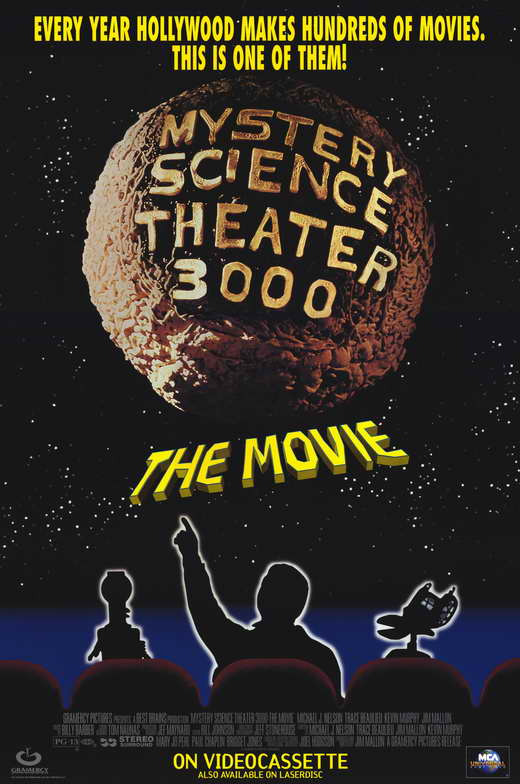
Look, the meme is about Favorite Movies, not necessarily the BEST Movies, OK? And for the most part this list consists of films where that division is less meaningful in terms of how I evaluate the other movies on here. But in this specific case, “Mystery Science Theater 3000: The Movie”, which is ultimately not all that different from the “Mystery Science Theater 3000″ TV show it spun off from and thus not particularly impressive as a work of Cinema Qua Cinema, makes the cut primarily because it’s a movie I know so well and have enjoyed so often that I can practically recite the whole thing to you by rote; I quote it all the time in my day-to-day life, I think about it often when I need a little smile, and it’s also become my favorite tool for introducing newcomers to MST3K as a whole since it was designed with a slightly broader audience in mind than the more willfully-eclectic series. And given how much I love MST3K As A Whole, that’s an especially strong factor in its favor.
8.)

Looky looky, @bunnikkila, we (unsurprisingly) have a pick in common! I’m sure this is the one and only time THAT’S going to happen on this list. 8D
Y’know, nearly thirty years (and one fairly useless remake >_>) later, I think the thing that impresses me about “The Lion King” is just how much it is still able to grab me emotionally. Some of that is unquestionably tied up with how strongly I associate this movie with my family, all of whom it became very special to as a Shared Experience. But I also don’t know of a lot of people who haven’t had that same emotional experience with it, and that to me suggests there’s more going on here than just Nostalgia. The mixture of Shakesperean plotting with Disney’s signature strength of Character, for one thing, granting the movie’s story an Epic Scope that never forgets the emotional inner lives of its cast. The music for another, not only its instantly-iconic song-book but also its memorable score, armed with both Big Bombast and Gentle Sentiment. And the unforgettably gorgeous animation, rendering every last element of its world with believable naturalism and strongly-defined personality. All of it, together, makes for what I still personally consider the Crowning Achievement of the Disney Renaissance.
7.)

I think, if I had to name the thing I find most lacking in far too many modern Action Movies, it’s Clarity. They all tend to lard their plots up with a bunch of unnecessary contrivances and complications in hopes of making themselves appear more clever than they actually are, and all it usually does is just dilute the impact of the whole thing. “Mad Max: Fury Road”, by contrast, is all about Clarity. I could sum up literally its entire plot in a paragraph if I wanted, because it is basically One Big Chase Scene from start to finish, never really deviating from that structure for more than a few minutes at a time. And that, combined with its exceptionally well-crafted Action Sequences, means that the full weight of its visceral power hits you full force every time. But don’t be fooled; that simplicity is not to be mistaken for shallowness. Indeed, precisely by getting out of its own way, knowing exactly what it wants to do and why, “Fury Road” also delivers a story that is, in spite of what you might guess, genuinely subtle and smart. Every character is immediately unforgettable and compelling because their role in the story is so well-considered and their personalities all so stark. The world it crafts feels at once fascinatingly surreal and yet All Too Real at the same time because even its most Fantastic elements are ultimately just grotesque reflections of things the audience knows only too well. And most of all, it tells a story with real, meaningful Themes that are deeply woven into each of its individual elements, such that the whole thing is deeply satisfying emotionally, but also piercingly Relevant in all the best, most affecting ways.
6.)

Oh look, another pick I have in common with @bunnikkila! This must be the last one, right?
But yeah, this is just a legitimately great movie, at every level, in every way. Stylistically, it is one of the most radically inventive things to have ever been made in the world of Western Animated Movies, gleefully mixing together a vast array of Aesthetics and Techniques that are at once viscerally distinct and yet coherently connected, all rendered with a fantastic eye toward the world of Comic Book Visual Language that keeps finding new and extremely fun ways to play with that instantly-recognizable iconography. For that alone, I would call it one of the greatest triumphs of 21st century animation. But then, on top of that, the story it tells is one that is simultaneously Arch and self-aware, delivering some of the most fantastically hilarious punch-lines imaginable more than a few of which are at the expense of the very franchise it is working within...but also entirely earnest, sincere, and emotionally affecting. It is, at once, a movie that manages to be about The Idea Of Spider-Man in its totality while also being about just one kid coming to grips with who he is, what he can do, and what his life can be. I don’t know that I can remember the last time a movie so immediately and unmistakably marked itself as an Enduring Masterpiece, but “Into the Spider-Verse” absolutely pulled it off.
5.)

Ordinarily, I would cheat and give this slot to the “Lord of the Rings” trilogy in its totality. But somehow, the fact that this is about “FAVORITE” movies instead of just what we think the BEST one is compels me to narrow it down to just one. And if I had to pick just one, it would be the first of the three, “Fellowship of the Ring”. It’s not necessarily anything that the other two movies get wrong, either. All three of the LotR movies possess many of its keenest strengths, after all. For a starter, there’s the keen understanding of how best to adapt the source material without being enslaved to it; capturing many of its most iconic moments while cleverly tweaking elements to make them more cinematic, knowing what scenes to focus on for the sake of more clearly focusing the emotional through-lines of the story, and knowing what scenes, no matter how good on the page, ultimately don’t fit to the shape the adaptation has taken. There’s also its pitch-perfect casting, each and every actor doing a fantastic job of embodying the characters so well that even as your personal vision of them from the books may differ radically from what is on-screen, they nonetheless end up feeling Right for the part and a strong, compelling presence. And there’s the deft visual hand of director Peter Jackson, who knows exactly how to craft a Middle Earth that feels at once lived-in and real but also Fantastic and magical. “Fellowship”, for me at least, thus wins out mostly because it has the good luck of being adapted from the strongest of the three books, the point at which the narrative is at its most unified and thus has the strongest overall momentum. But also because so few movies have so swept me away with the sense of stepping into a world I have always dreamed of in my mind’s eye, and that’s the sort of thing that can only happen at the beginning of a journey.
4.)
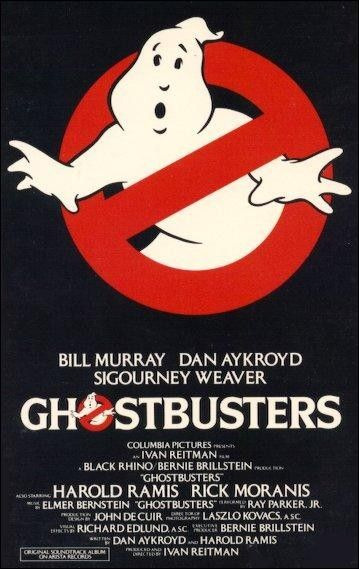
Now here’s a movie that is literally sown in to my very being. It’s the last movie my mother saw in theaters before becoming a Mom. I grew up watching the “Real Ghostbusters” cartoon all the time and playing with the attendant toys; I had a “Ghostbusters” Birthday Party when I was, like, four years old. It has been my annual Halloween Tradition to get myself a big Cheese Pizza and watch this movie for about as long as I’ve had disposable income to myself. There is, quite literally, no point in my life where I don’t remember “Ghostbusters” being a fixture in it. And as a nice bonus? It is, legitimately, a Genuinely Great Movie. I realize that isn’t quite as universally agreed upon these days as it was even a few years ago (thanks, Literally The Worst Kind Of Virulently Misogynist Assholes lD; ), but I still feel pretty confident in saying this one really is That Good. I still find basically every one of its jokes hilarious; even now I could quote just about any one of them and get a laugh. I still find its central premise, What If Exorcism Was A Blue-Collar Business, a brilliant, almost subversively clever one that takes The Supernatural out of the realm of The Unknowable and into a world where even you, an ordinary person off the street, can in fact fight back against it. I still think it’s one of the all-time great examples of how to balance Tone in this sort of High Concept Genre Bender, by allowing The Story to be played relatively straight while allowing the comedy to flow naturally from the characters’ reactions to that story, allowing its Ghostly aspects to land as Genuinely Scary (or at least Worth Taking Seriously) without getting too Stern and Serious about it. And I still listen to that unforgettable Title Song all the time! So yeah, even if I could be more objective about it, “Ghostbusters” would almost certainly make this cut.
3.)
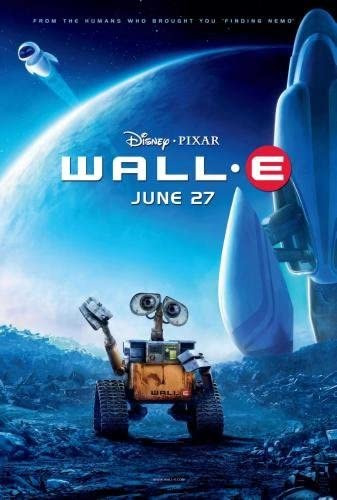
And so we come to the third and last pick I have in common with @bunnikkila, not coincidentally a movie that played a key role in solidifying our friendship, as bonding over our shared love of it was a big part of how we got to know each other on deviantART waaaay back in the day <3
By 2008, I really didn’t think it was possible for a movie or comic or TV show to really become “part” of me anymore, the way things like Sonic the Hedgehog or Marvel Super Heroes or Some Other Movie Character Who Might Be At The Top Of This List had. And then “WALL-E” came along and proved that to be completely, utterly wrong. I didn’t just love this movie, I was inspired by it, to a degree of strength and consistency that I’m still not entirely sure has yet been matched. And to be sure, some of that is undoubtedly because the movie had already basically won the war before I’d even bought my ticket; Adorable Robots In Love is something like My Platonic Storytelling Ideal, after all. But even setting that aside, “WALL-E” is a movie where even now I can’t help but be keenly aware, and gently awed, at the beauty of its craft; indeed, watching this movie in a theater did a lot to make me better understand why movies work on us the way they do, because I left that theater chewing so much on every last one of its elements. Its gorgeous animation, the way it conveys Character through Actions more so than language, the dream-like quality of its musical score (even as i type this i get teary thinking about certain motifs), the clear and meaningful way it builds its theme and story together so harmoniously, and the particular perspective it takes on our relationships with each other, with our environments, and with our own technology...all of it speaks to me deeply and profoundly, and it’s no coincidence that I have seen this movie more times in theaters than any other on this list (twelve times, for the record, and I still remember each and every time XD).
2.)

This one needs no personal qualifications, to my mind. Yes, I have some degree of nostalgic attachment to it for having seen it relatively young with my brothers and being deeply moved by it then, but it’s not at all like the kind of Nostalgia I have for “The Lion King”. “Princess Mononoke” is just flat-out, full-stop a complete Masterpiece, not just my personal pick for one of the single-best animated films ever made, but one of the best films period. It’s almost difficult for me to put into words how great this movie is, certainly in a way that hasn’t been repeated to death by thousands of other smarter people, because no one of its elements quite answers the question of why it is so great, to my mind. Yes, the animation is absolutely gorgeous with a design sensibility that brings Ancient Mythology to life so vividly that its influence can still be felt today (The Forest Spirit alone has been homaged all over the place). And yes, the music is hauntingly beautiful, at once capturing the gentle rhythm of nature but also the elegiac tone of Life Moving On. And yes, the story is an incredible mixture of the Broad Mythic Strokes of an Ancient Legend grounded in all too human Emotions and Ideas about the balance of nature, the full meaning and cost of Warfare, and perhaps most important of all, about how we determine Right and Wrong when everyone involved in a conflict is fighting simply for the right to survive. But all of those things add up together to something even greater than a simple sum, because each one isn’t just good in its own right but because each element so perfectly reinforces the other. And even having said all that? I really could just carry on singing this movie’s praises. Just...an absolute masterpiece, top to bottom.
1.)
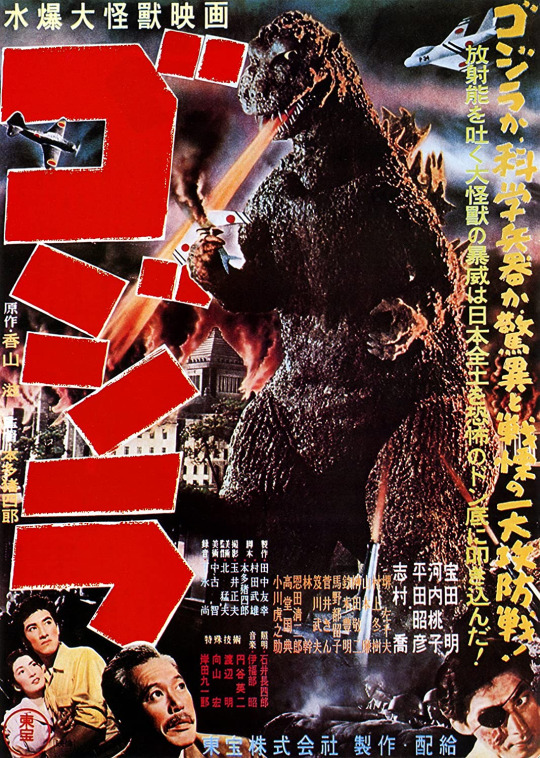
I don’t imagine any of you are terribly surprised at this, right? I almost feel like it’d be redundant to explain my love for this movie, given how self-obvious I imagine it is to basically everyone who knows me Literally At All. But heck, I’ve rambled on this long, why not go all the way? Because the thing of it is, “Gojira” (to be clear, the original Japanese movie from 1954 rather than its American edit, “Godzilla: King of the Monsters” from 1956) doesn’t just top the list by being a Great Movie. Though to be clear, it really is. Flawless? No; there’s a reliance on puppetry that even for the time can be a bit chintzier than the movie can really afford, in particular. But brilliant, even so, a heart-wrenching example of Science Fiction Storytelling As Allegory, one that, in a rarity not just for its own genre but indeed for many movies in general, very meaningfully lingers on its deepest, darkest implications. Many a film critic has pointed it out, and it remains true: the stark black-and-white photography heightens the sense of Implacable Horror at the core of the story, and the way the central Melodrama, a tragic love triangle that carries with it many aspects of Class Conflict and Personal Desire VS. The Collective Good, ties back into the main story is truly beautiful in its elegance and emotional impact. Still, for me personally, it tops the list, now and always, because it is a movie that affirmed something for me, that the character I had fallen in love with as a child convincing his family to watch a monster movie with him on television to prove his seven-year-old bravery, really was as genuinely as powerful and meaningful a figure as I had always imagined him to be.
3 notes
·
View notes
Text
February Picks

And just like that another month is coming to a close. I can’t believe how fast it has gone by. I’ve continued watching some favorites from last month and am sad some have come to an end. Meanwhile a bunch of shows came back from their winter hiatus, so it was a lot of fun getting back into their story-lines again.
Be prepared for spoilers once again...

SANDITON
Masterpiece’s Sanditon ended this past Sunday, here in the states, and I am jumping on the campaign that we need a season 2! It can’t end like that with so many open ended story-lines (okay maybe just one or two, but still we deserve more).
Who would have guessed that Esther would become one of my favorite characters in this series and that’s mainly thanks to her well written character development. From the “villain” in episode 1 she grew into so much more and was such a complex character. I really enjoyed watching her story unfold. I am SO HAPPY she married Babington and his speech to her about living side by side, knowing he loves her more and just wants to see her happy. Wow....Goals. I want to see this relationship progress even more (if that’s possible) with a season 2. Speaking of things I want to see: Will Sanditon be rebuilt and how long will it take? Will there be an alternative allowing Sidney to be with Charlotte? Major twist there as their relationship doesn’t end with a happily ever after (very un-Austen like for the main protagonists). When he returned at the end stopping Charlotte’s carriage, I seriously thought he would have said he broke up his engagement, but alas. The previous episode I really wanted them together (thanks to Sidney’s speech to Charlotte when he told her his ex-fiance left and how Charlotte makes him a better person *melts* and of course their dancing scene the episode prior was amazing). In the early parts of the season, while I knew Charlotte and Sidney would be a thing-eventually, I couldn’t help but have a soft spot for Young Stringer’s character and my appreciation never truly left. I felt he was paired well with Charlotte. Such a tragic ending for him. He wanted to better himself (much like the Parker brothers) but after his father’s death he no longer will. Throughout the series, I enjoyed Miss Lambe’s character, but I agree with many reviews that I was reading that her character was kind of dropped at the end. I’m curious what her reaction will be when she finds out about SIdney’s engagement...
Thank you again, Andrew Davies. I was not expecting to like this adaptation so much.
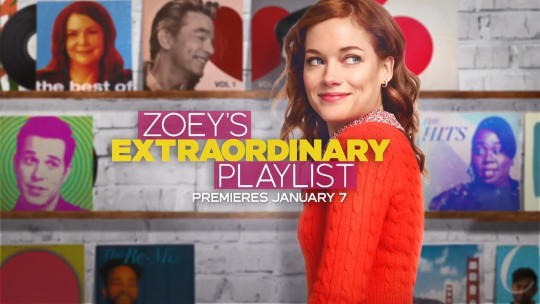
ZOEY’S EXTRAORDINARY PLAYLIST
The best way to describe one of NBC’s latest shows is that I feel happy and in a good mood whenever I finish an episode. (And then I’m immediately upset that I have to wait a week for the next one. I watch them too fast.) I’ve heard many people compare it to Glee and while I could definitely understand that I keep getting drawn back to Abc’s short lived Eli Stone. There Eli (played by Jonny Lee Miller) could hear people around him sing and dance, which helped him solve upcoming law cases. In this show he was experiencing a brain tumor, but so far Zoey seems all clear. Instead, a freak accident while she is getting an MRI scan and listening to music, allows for her to hear people sing (and perform) their innermost feelings. There’s still some logistics to discover like what Zoey looks like when she watches these performances (does she move around or look like she’s just staring into the air. I might be thinking into this too much...I know). We just recently found out that sometimes she can speak to others as they are happening. Each time she hears someone sing she is meant to help them with something in their life. It could be a family member, co worker, friend, or like this past week her boss. While there’s one major problem (that she has to fix), there are often multiple songs in one episode which I really enjoy. The cast is also very strong, both musically and as actors. I can’t wait to see where the rest of the season is headed!
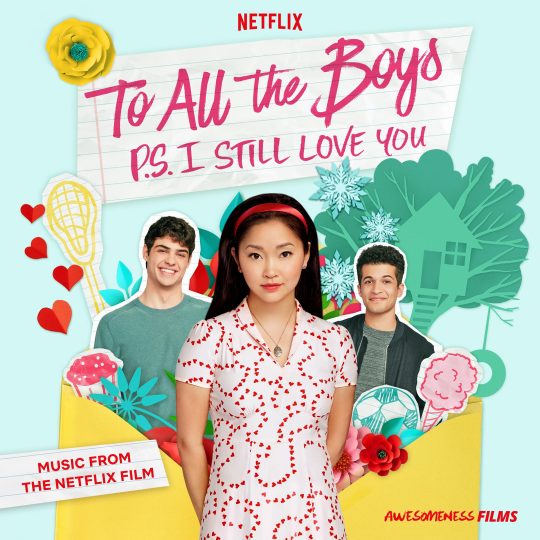
TO ALL THE BOYS P.S. I STILL LOVE YOU
When the first film was released on Netflix about 2 years ago, I was instantly a fan. I was unfamiliar with the book, but quickly added to my TBR list. (My to read list is extremely long, so I still haven’t gotten to it. Story of my life.) I really enjoyed watching Lara Jean experience the results of having her secretive love letters distributed to her past crushes. I was definitely Team Peter and Lara by the end of the film. They were adorable. The sequel was released earlier this month and I kind of forgot about it. It felt like we had been preparing for the sequel for a bit and then I must have been watching too much Disney Plus to miss the trailer. Watching P.S. I still love you, I just missed the original film. There were parts I liked and I was a big fan of John Ambrose (and of course Jordan Fisher because he’s great), but overall I felt like much didn’t happen. Also, Lara and Peter’s relationship kind of bothered me in parts. I understand that for both of them this was the first time they were in this kind of relationship and could feel awkward about certain things (like the Valentine’s singing-gram or writing an original poem). The main part I did like about them was towards the end when he arrived at the retirement home. I don’t say this often, but I have no want to re-watch it any time soon.

VIOLETTA SEASON 1
Speaking of Disney Plus....
In a quick month and a half I have successfully watched ALL 80 episodes of season 1 of Violetta. I feel so accomplished and know the withdrawal will happen very soon. (I just finished last night and I’ve been listening to the music a lot recently). I’m so upset that season 2 has not be released on Disney Plus yet. I thought it would be by now because the streaming service has been up for a good amount of months and this show was so popular around the world. Unfortunately, I have not been lucky with my Google searches for when they’ll release it and no luck with YouTube either (no English caption options). I’ve been hearing that season 2 is really great because season 1 did a nice job of establishing these characters and now we get to see more story-lines. I will miss the students and teachers at the Studio as well the home-life at the Castillo’s house. Throughout 80 episodes it’s understandable to love and hate several characters as you’re with them for a good amount of time. For some people it was a roller coaster, but there were a good amount that I liked pretty consistently. I am a fan of Violetta and Leon and they had some super cute moments. I think it was about episode 35 where I truly felt like connection. When Tomas left the love triangle for a bit I actually grew to like him and would often joke how he never smiled and had a Tomas face. I really liked You Mix and the introduction of Frederico. Some great songs came out of that section like Ven y Canta and Tienes el Talento, but my favorite is definitely Ser Mejor. And of course, I will always have love for Pablo. I can’t believe I’m saying this, but I’m going to miss reading subtitles (I really do feel like I know more Spanish now). Definitely check out this show if you want something drama filled and funny at the same time.

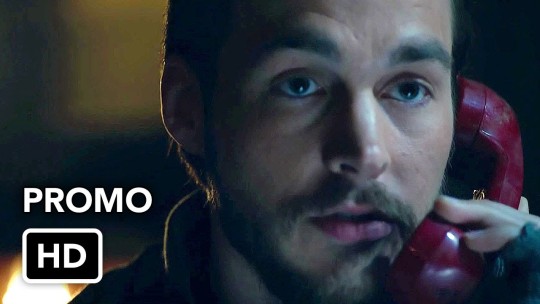
LEGACIES
I know I dedicated a whole post to Chris Wood’s return as Kai Parker on Legacies. (See the article here:https://talesofafangirlwithadvr.tumblr.com/post/190761328673/omg-legacies-2x12) But I still had to include it in this wrap up because once again Legacies is doing a great job this season. I was so excited to see it when it came back from the mid-season hiatus. Since the return of Wood it has gotten more of a TVD vibe than usual, which is great. I haven’t watched the last episode, but have seen a clip of Kai masquerading at the school. I am going to be very interested to see for how long he hangs around and how long it takes for them to discover him AND how Josie handles the evil inside of her.
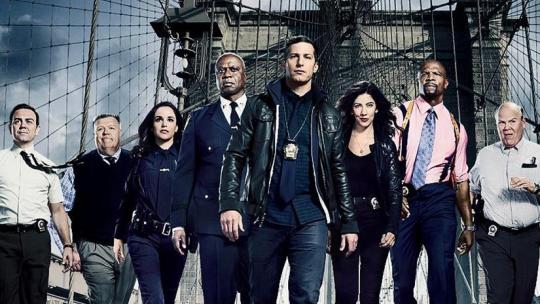
BROOKLYN NINE NINE
Thank goodness this show got renewed (and picked up from NBC). When it started a couple of weeks ago, I was reminded how much I missed it. I can’t get over that this is already the second season on NBC. As usual the hi-jinks of the Nine Nine have been entertaining to watch. The Jimmy Jab games were great. I loved how Hitchcock was so desperate to win that he was taking Scully’s array of pills. What an ending with Debbie! Did not think she could be capable of that. I can’t wait to see the outcome next episode. I’m so excited for a Santiago-Peralta baby. It was a great episode when they were hiding it from Charles and Adrian returned. I’ve seen the movie Memento and it is great! It was hilarious each time he was like, ‘I don’t know what that is’ and then saying ‘Finding Dory’ solved everything. I am so happy that this show was suggested for me to watch and fill my Office and Parks and Rec void. Whenever a new episode’s on the DVR I can’t wait to watch it.

LEGENDS OF TOMORROW
And last, but certainly not least, DC’s Legends of Tomorrow has once again not disappointed me this season (I know it’s still early, but I’m optimistic). It started at the end of January following the events of Crisis and I liked how this season transitioned with all the changes (the major one being the introduction of Zari’s brother). I am really happy to see her again though and how she is having these flashes of her old life on board the Wave-rider. I can’t wait to see that reveal happen (especially because as of right now only Nate knows the ‘truth’). I love seeing Ava as a permanent part of the Legends crew and as stepping in as Captain when Sara was away. She is a great addition and I like how quirky she is since we first met her. Her and Sara are perfect. I also love Ray and Nora. Nora as a fairy godmother is fantastic. One of my favorite episodes was the one with the 80s dance. Her role in all of that was great and her realization with what she can provide for these kids. I feel like this is going to be the reason Ray leaves the Legends. I remember seeing Brandon Routh’s Instagram Post about leaving the show and this feels like the reason he will. I hope that isn’t for a while though because I am going to miss him a lot.
Until March!
#sanditon#masterpiece sanditon#sidney parker#charlotte heywood#sidney x charlotte#esther denham#esther x babington#renew sanditon#zoey's extraordinary playlist#team simon or team max#to all the boys ps i love you#lara jean#disney’s violetta#violetta season 1#we want season 2 disney plus#violetta season 2#Legacies#legacies season 2#kai parker is back#brooklyn nine nine#jake x amy#dc legends of tomorrow
21 notes
·
View notes